Leisure Shopping: Impact on Village Centers
VerifiedAdded on 2023/01/19
|25
|6084
|79
AI Summary
This research explores the economic impact of leisure shopping on village centers and compares the mean number of hours spent by gender. The findings reveal that leisure shopping has a significant impact on village shops and females tend to spend more time than males.
Contribute Materials
Your contribution can guide someone’s learning journey. Share your
documents today.

Leisure shopping
Secure Best Marks with AI Grader
Need help grading? Try our AI Grader for instant feedback on your assignments.

Executive summary
The purpose of this research was to answer the following two questions; how do the mean
number of hours spent in a day compare by gender of the participants? And is there economic
impact of leisure shopping on village centers? The methodology that was employed in this
research was correlational and descriptive research designs which helped in checking for the
relationship between variables and also obtaining the frequencies of the data. The results from
the research were as follows;
It was then found from the results that there was mean difference between the number of
hours spent by male leisure shopping customers and female leisure shopping customers in
a day.
Also, it was found that leisure shopping had economic impact on the shops in the village
centers where people visited and leisure shopping took place.
From the results therefore, it was concluded leisure activities were important and had economic
impact on the shops in the village centers and that females who engaged in leisure shopping
tended to take much longer time than their male counterparts as it was evident from the
hypothesis tested in study.
The purpose of this research was to answer the following two questions; how do the mean
number of hours spent in a day compare by gender of the participants? And is there economic
impact of leisure shopping on village centers? The methodology that was employed in this
research was correlational and descriptive research designs which helped in checking for the
relationship between variables and also obtaining the frequencies of the data. The results from
the research were as follows;
It was then found from the results that there was mean difference between the number of
hours spent by male leisure shopping customers and female leisure shopping customers in
a day.
Also, it was found that leisure shopping had economic impact on the shops in the village
centers where people visited and leisure shopping took place.
From the results therefore, it was concluded leisure activities were important and had economic
impact on the shops in the village centers and that females who engaged in leisure shopping
tended to take much longer time than their male counterparts as it was evident from the
hypothesis tested in study.
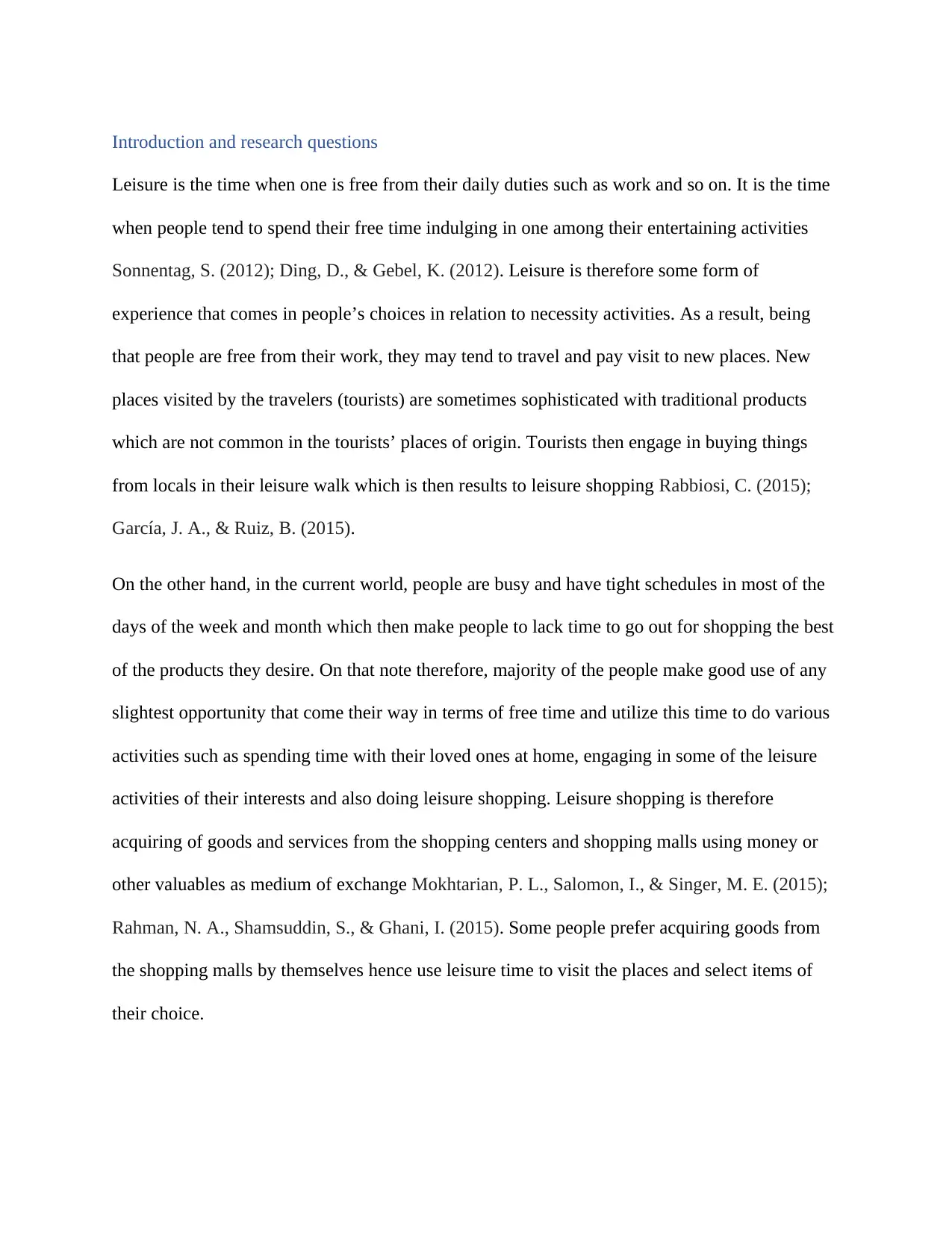
Introduction and research questions
Leisure is the time when one is free from their daily duties such as work and so on. It is the time
when people tend to spend their free time indulging in one among their entertaining activities
Sonnentag, S. (2012); Ding, D., & Gebel, K. (2012). Leisure is therefore some form of
experience that comes in people’s choices in relation to necessity activities. As a result, being
that people are free from their work, they may tend to travel and pay visit to new places. New
places visited by the travelers (tourists) are sometimes sophisticated with traditional products
which are not common in the tourists’ places of origin. Tourists then engage in buying things
from locals in their leisure walk which is then results to leisure shopping Rabbiosi, C. (2015);
García, J. A., & Ruiz, B. (2015).
On the other hand, in the current world, people are busy and have tight schedules in most of the
days of the week and month which then make people to lack time to go out for shopping the best
of the products they desire. On that note therefore, majority of the people make good use of any
slightest opportunity that come their way in terms of free time and utilize this time to do various
activities such as spending time with their loved ones at home, engaging in some of the leisure
activities of their interests and also doing leisure shopping. Leisure shopping is therefore
acquiring of goods and services from the shopping centers and shopping malls using money or
other valuables as medium of exchange Mokhtarian, P. L., Salomon, I., & Singer, M. E. (2015);
Rahman, N. A., Shamsuddin, S., & Ghani, I. (2015). Some people prefer acquiring goods from
the shopping malls by themselves hence use leisure time to visit the places and select items of
their choice.
Leisure is the time when one is free from their daily duties such as work and so on. It is the time
when people tend to spend their free time indulging in one among their entertaining activities
Sonnentag, S. (2012); Ding, D., & Gebel, K. (2012). Leisure is therefore some form of
experience that comes in people’s choices in relation to necessity activities. As a result, being
that people are free from their work, they may tend to travel and pay visit to new places. New
places visited by the travelers (tourists) are sometimes sophisticated with traditional products
which are not common in the tourists’ places of origin. Tourists then engage in buying things
from locals in their leisure walk which is then results to leisure shopping Rabbiosi, C. (2015);
García, J. A., & Ruiz, B. (2015).
On the other hand, in the current world, people are busy and have tight schedules in most of the
days of the week and month which then make people to lack time to go out for shopping the best
of the products they desire. On that note therefore, majority of the people make good use of any
slightest opportunity that come their way in terms of free time and utilize this time to do various
activities such as spending time with their loved ones at home, engaging in some of the leisure
activities of their interests and also doing leisure shopping. Leisure shopping is therefore
acquiring of goods and services from the shopping centers and shopping malls using money or
other valuables as medium of exchange Mokhtarian, P. L., Salomon, I., & Singer, M. E. (2015);
Rahman, N. A., Shamsuddin, S., & Ghani, I. (2015). Some people prefer acquiring goods from
the shopping malls by themselves hence use leisure time to visit the places and select items of
their choice.
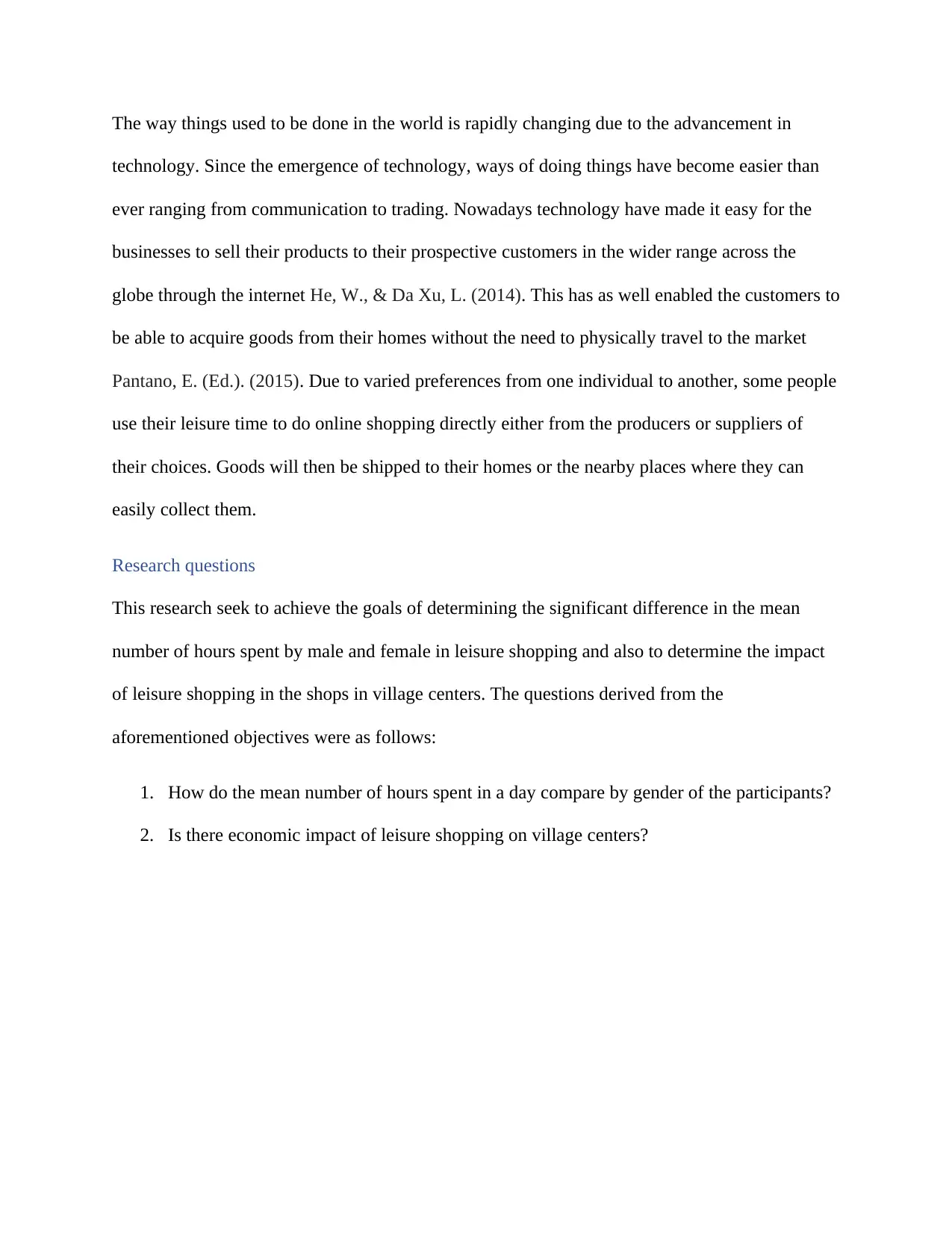
The way things used to be done in the world is rapidly changing due to the advancement in
technology. Since the emergence of technology, ways of doing things have become easier than
ever ranging from communication to trading. Nowadays technology have made it easy for the
businesses to sell their products to their prospective customers in the wider range across the
globe through the internet He, W., & Da Xu, L. (2014). This has as well enabled the customers to
be able to acquire goods from their homes without the need to physically travel to the market
Pantano, E. (Ed.). (2015). Due to varied preferences from one individual to another, some people
use their leisure time to do online shopping directly either from the producers or suppliers of
their choices. Goods will then be shipped to their homes or the nearby places where they can
easily collect them.
Research questions
This research seek to achieve the goals of determining the significant difference in the mean
number of hours spent by male and female in leisure shopping and also to determine the impact
of leisure shopping in the shops in village centers. The questions derived from the
aforementioned objectives were as follows:
1. How do the mean number of hours spent in a day compare by gender of the participants?
2. Is there economic impact of leisure shopping on village centers?
technology. Since the emergence of technology, ways of doing things have become easier than
ever ranging from communication to trading. Nowadays technology have made it easy for the
businesses to sell their products to their prospective customers in the wider range across the
globe through the internet He, W., & Da Xu, L. (2014). This has as well enabled the customers to
be able to acquire goods from their homes without the need to physically travel to the market
Pantano, E. (Ed.). (2015). Due to varied preferences from one individual to another, some people
use their leisure time to do online shopping directly either from the producers or suppliers of
their choices. Goods will then be shipped to their homes or the nearby places where they can
easily collect them.
Research questions
This research seek to achieve the goals of determining the significant difference in the mean
number of hours spent by male and female in leisure shopping and also to determine the impact
of leisure shopping in the shops in village centers. The questions derived from the
aforementioned objectives were as follows:
1. How do the mean number of hours spent in a day compare by gender of the participants?
2. Is there economic impact of leisure shopping on village centers?
Secure Best Marks with AI Grader
Need help grading? Try our AI Grader for instant feedback on your assignments.
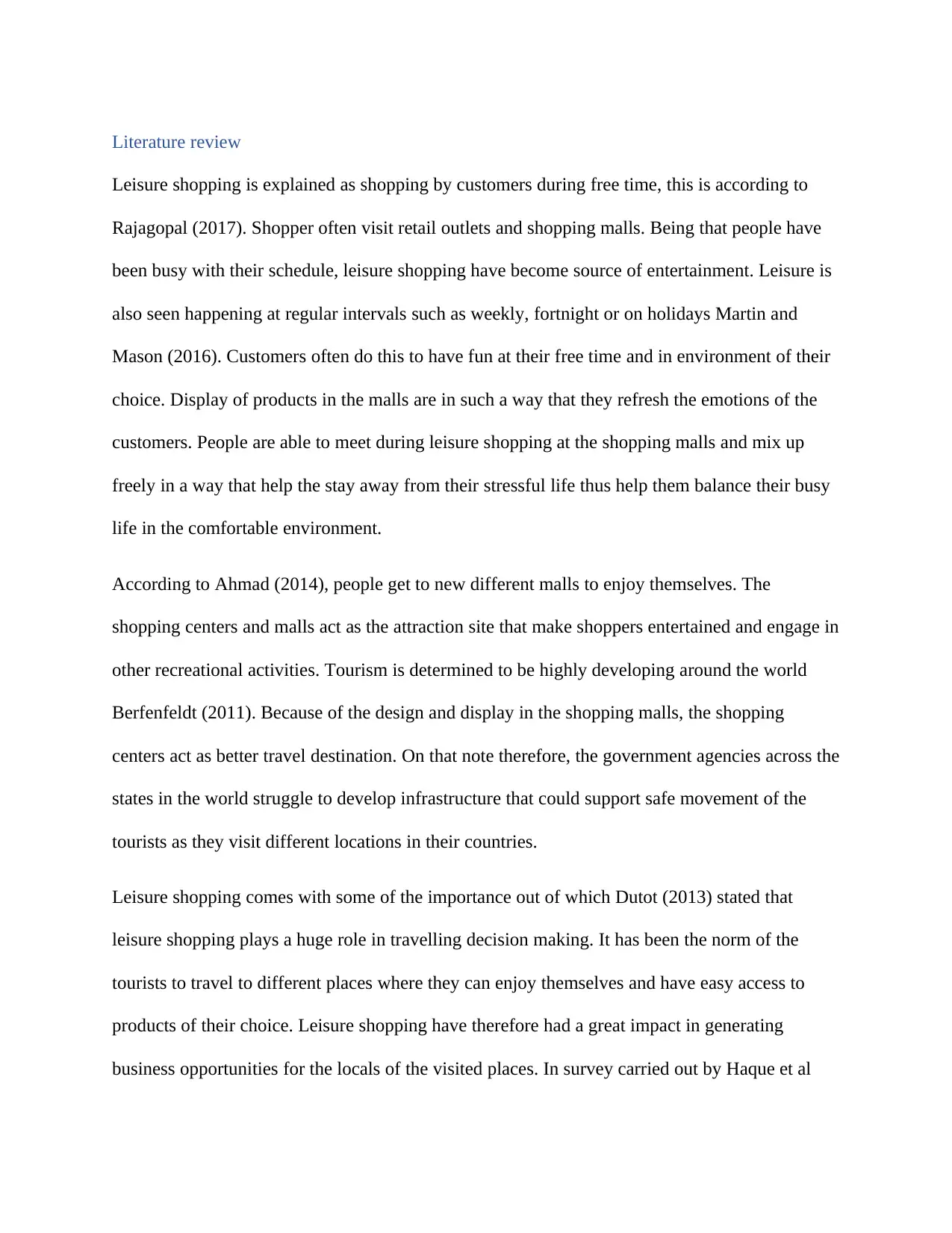
Literature review
Leisure shopping is explained as shopping by customers during free time, this is according to
Rajagopal (2017). Shopper often visit retail outlets and shopping malls. Being that people have
been busy with their schedule, leisure shopping have become source of entertainment. Leisure is
also seen happening at regular intervals such as weekly, fortnight or on holidays Martin and
Mason (2016). Customers often do this to have fun at their free time and in environment of their
choice. Display of products in the malls are in such a way that they refresh the emotions of the
customers. People are able to meet during leisure shopping at the shopping malls and mix up
freely in a way that help the stay away from their stressful life thus help them balance their busy
life in the comfortable environment.
According to Ahmad (2014), people get to new different malls to enjoy themselves. The
shopping centers and malls act as the attraction site that make shoppers entertained and engage in
other recreational activities. Tourism is determined to be highly developing around the world
Berfenfeldt (2011). Because of the design and display in the shopping malls, the shopping
centers act as better travel destination. On that note therefore, the government agencies across the
states in the world struggle to develop infrastructure that could support safe movement of the
tourists as they visit different locations in their countries.
Leisure shopping comes with some of the importance out of which Dutot (2013) stated that
leisure shopping plays a huge role in travelling decision making. It has been the norm of the
tourists to travel to different places where they can enjoy themselves and have easy access to
products of their choice. Leisure shopping have therefore had a great impact in generating
business opportunities for the locals of the visited places. In survey carried out by Haque et al
Leisure shopping is explained as shopping by customers during free time, this is according to
Rajagopal (2017). Shopper often visit retail outlets and shopping malls. Being that people have
been busy with their schedule, leisure shopping have become source of entertainment. Leisure is
also seen happening at regular intervals such as weekly, fortnight or on holidays Martin and
Mason (2016). Customers often do this to have fun at their free time and in environment of their
choice. Display of products in the malls are in such a way that they refresh the emotions of the
customers. People are able to meet during leisure shopping at the shopping malls and mix up
freely in a way that help the stay away from their stressful life thus help them balance their busy
life in the comfortable environment.
According to Ahmad (2014), people get to new different malls to enjoy themselves. The
shopping centers and malls act as the attraction site that make shoppers entertained and engage in
other recreational activities. Tourism is determined to be highly developing around the world
Berfenfeldt (2011). Because of the design and display in the shopping malls, the shopping
centers act as better travel destination. On that note therefore, the government agencies across the
states in the world struggle to develop infrastructure that could support safe movement of the
tourists as they visit different locations in their countries.
Leisure shopping comes with some of the importance out of which Dutot (2013) stated that
leisure shopping plays a huge role in travelling decision making. It has been the norm of the
tourists to travel to different places where they can enjoy themselves and have easy access to
products of their choice. Leisure shopping have therefore had a great impact in generating
business opportunities for the locals of the visited places. In survey carried out by Haque et al
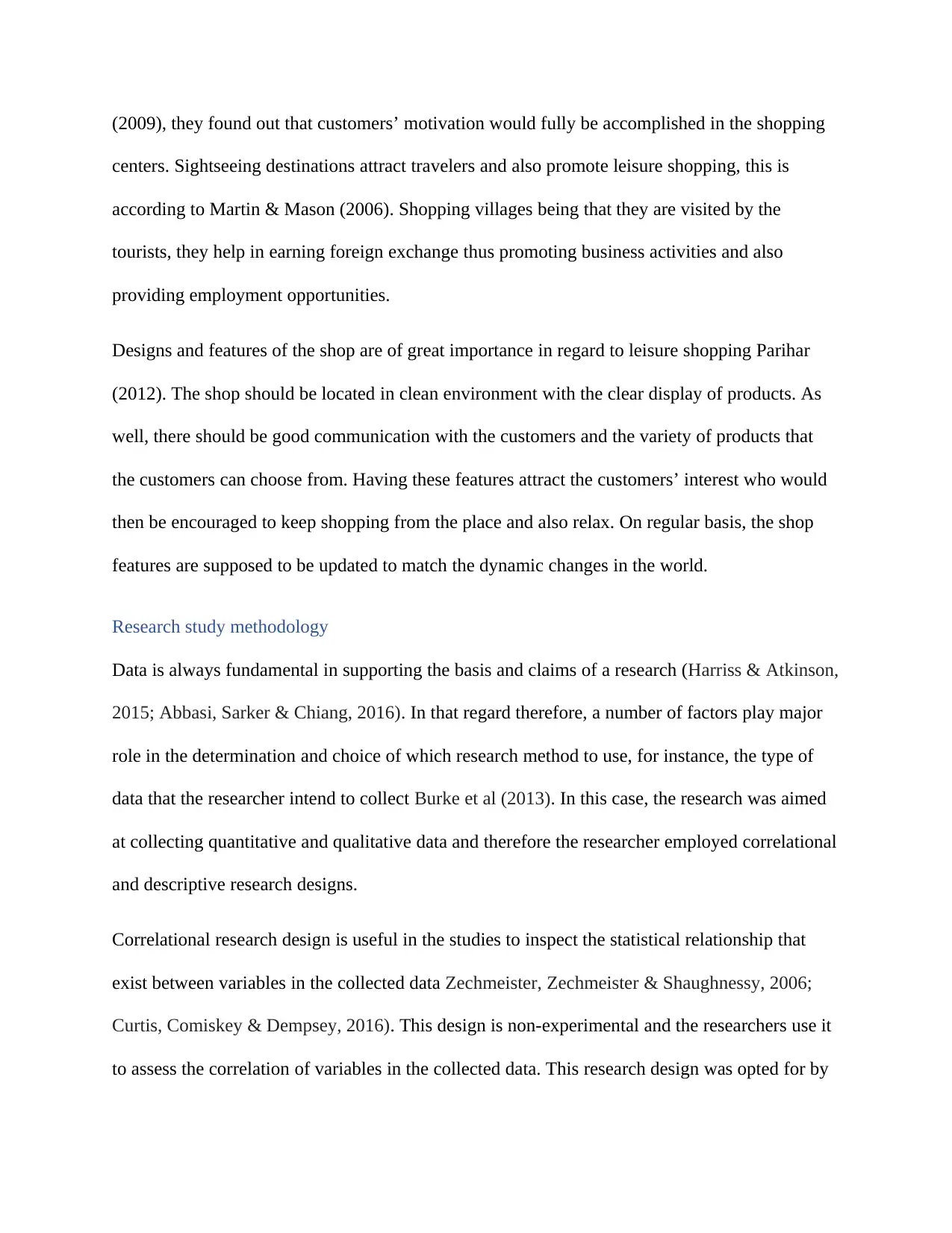
(2009), they found out that customers’ motivation would fully be accomplished in the shopping
centers. Sightseeing destinations attract travelers and also promote leisure shopping, this is
according to Martin & Mason (2006). Shopping villages being that they are visited by the
tourists, they help in earning foreign exchange thus promoting business activities and also
providing employment opportunities.
Designs and features of the shop are of great importance in regard to leisure shopping Parihar
(2012). The shop should be located in clean environment with the clear display of products. As
well, there should be good communication with the customers and the variety of products that
the customers can choose from. Having these features attract the customers’ interest who would
then be encouraged to keep shopping from the place and also relax. On regular basis, the shop
features are supposed to be updated to match the dynamic changes in the world.
Research study methodology
Data is always fundamental in supporting the basis and claims of a research (Harriss & Atkinson,
2015; Abbasi, Sarker & Chiang, 2016). In that regard therefore, a number of factors play major
role in the determination and choice of which research method to use, for instance, the type of
data that the researcher intend to collect Burke et al (2013). In this case, the research was aimed
at collecting quantitative and qualitative data and therefore the researcher employed correlational
and descriptive research designs.
Correlational research design is useful in the studies to inspect the statistical relationship that
exist between variables in the collected data Zechmeister, Zechmeister & Shaughnessy, 2006;
Curtis, Comiskey & Dempsey, 2016). This design is non-experimental and the researchers use it
to assess the correlation of variables in the collected data. This research design was opted for by
centers. Sightseeing destinations attract travelers and also promote leisure shopping, this is
according to Martin & Mason (2006). Shopping villages being that they are visited by the
tourists, they help in earning foreign exchange thus promoting business activities and also
providing employment opportunities.
Designs and features of the shop are of great importance in regard to leisure shopping Parihar
(2012). The shop should be located in clean environment with the clear display of products. As
well, there should be good communication with the customers and the variety of products that
the customers can choose from. Having these features attract the customers’ interest who would
then be encouraged to keep shopping from the place and also relax. On regular basis, the shop
features are supposed to be updated to match the dynamic changes in the world.
Research study methodology
Data is always fundamental in supporting the basis and claims of a research (Harriss & Atkinson,
2015; Abbasi, Sarker & Chiang, 2016). In that regard therefore, a number of factors play major
role in the determination and choice of which research method to use, for instance, the type of
data that the researcher intend to collect Burke et al (2013). In this case, the research was aimed
at collecting quantitative and qualitative data and therefore the researcher employed correlational
and descriptive research designs.
Correlational research design is useful in the studies to inspect the statistical relationship that
exist between variables in the collected data Zechmeister, Zechmeister & Shaughnessy, 2006;
Curtis, Comiskey & Dempsey, 2016). This design is non-experimental and the researchers use it
to assess the correlation of variables in the collected data. This research design was opted for by
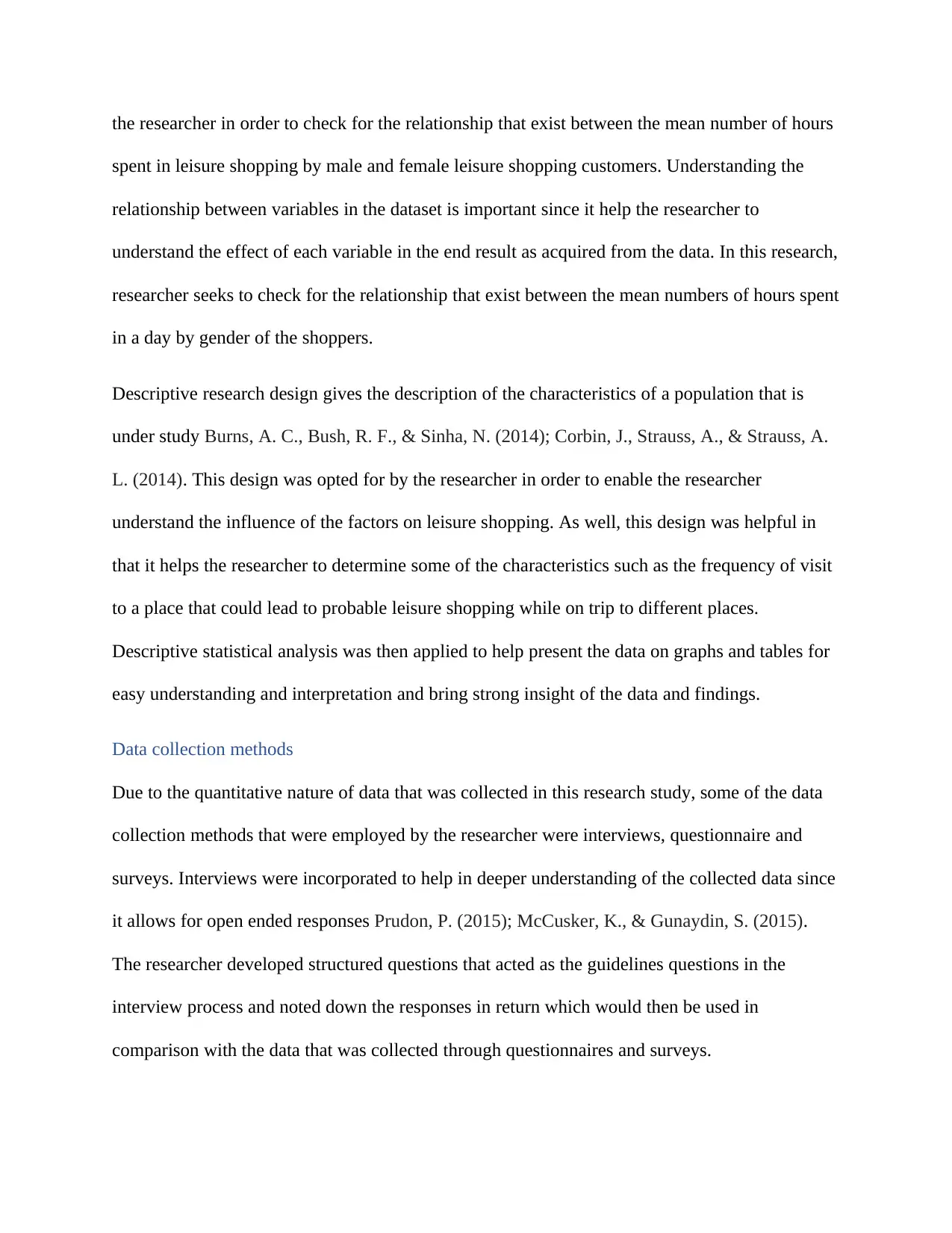
the researcher in order to check for the relationship that exist between the mean number of hours
spent in leisure shopping by male and female leisure shopping customers. Understanding the
relationship between variables in the dataset is important since it help the researcher to
understand the effect of each variable in the end result as acquired from the data. In this research,
researcher seeks to check for the relationship that exist between the mean numbers of hours spent
in a day by gender of the shoppers.
Descriptive research design gives the description of the characteristics of a population that is
under study Burns, A. C., Bush, R. F., & Sinha, N. (2014); Corbin, J., Strauss, A., & Strauss, A.
L. (2014). This design was opted for by the researcher in order to enable the researcher
understand the influence of the factors on leisure shopping. As well, this design was helpful in
that it helps the researcher to determine some of the characteristics such as the frequency of visit
to a place that could lead to probable leisure shopping while on trip to different places.
Descriptive statistical analysis was then applied to help present the data on graphs and tables for
easy understanding and interpretation and bring strong insight of the data and findings.
Data collection methods
Due to the quantitative nature of data that was collected in this research study, some of the data
collection methods that were employed by the researcher were interviews, questionnaire and
surveys. Interviews were incorporated to help in deeper understanding of the collected data since
it allows for open ended responses Prudon, P. (2015); McCusker, K., & Gunaydin, S. (2015).
The researcher developed structured questions that acted as the guidelines questions in the
interview process and noted down the responses in return which would then be used in
comparison with the data that was collected through questionnaires and surveys.
spent in leisure shopping by male and female leisure shopping customers. Understanding the
relationship between variables in the dataset is important since it help the researcher to
understand the effect of each variable in the end result as acquired from the data. In this research,
researcher seeks to check for the relationship that exist between the mean numbers of hours spent
in a day by gender of the shoppers.
Descriptive research design gives the description of the characteristics of a population that is
under study Burns, A. C., Bush, R. F., & Sinha, N. (2014); Corbin, J., Strauss, A., & Strauss, A.
L. (2014). This design was opted for by the researcher in order to enable the researcher
understand the influence of the factors on leisure shopping. As well, this design was helpful in
that it helps the researcher to determine some of the characteristics such as the frequency of visit
to a place that could lead to probable leisure shopping while on trip to different places.
Descriptive statistical analysis was then applied to help present the data on graphs and tables for
easy understanding and interpretation and bring strong insight of the data and findings.
Data collection methods
Due to the quantitative nature of data that was collected in this research study, some of the data
collection methods that were employed by the researcher were interviews, questionnaire and
surveys. Interviews were incorporated to help in deeper understanding of the collected data since
it allows for open ended responses Prudon, P. (2015); McCusker, K., & Gunaydin, S. (2015).
The researcher developed structured questions that acted as the guidelines questions in the
interview process and noted down the responses in return which would then be used in
comparison with the data that was collected through questionnaires and surveys.
Paraphrase This Document
Need a fresh take? Get an instant paraphrase of this document with our AI Paraphraser
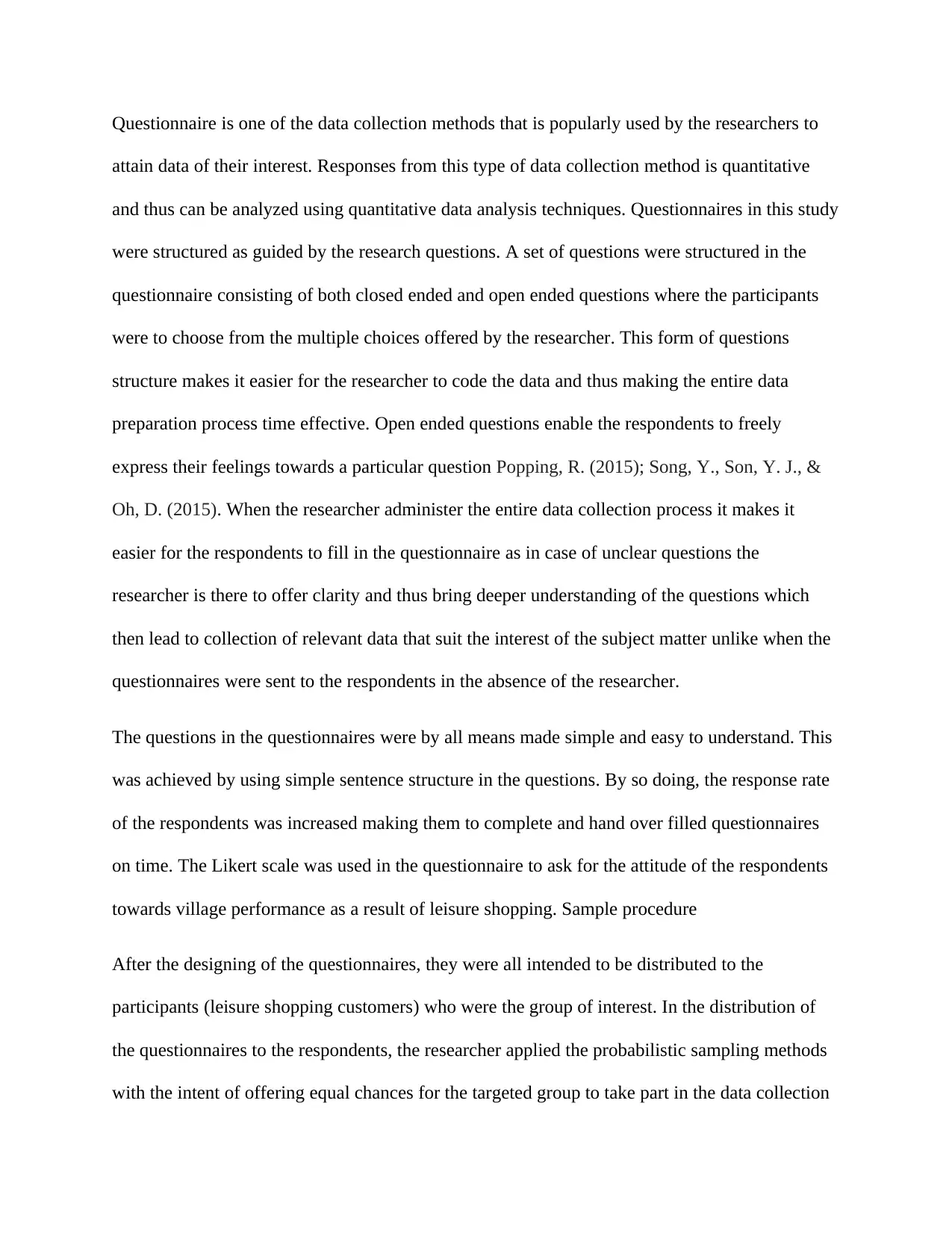
Questionnaire is one of the data collection methods that is popularly used by the researchers to
attain data of their interest. Responses from this type of data collection method is quantitative
and thus can be analyzed using quantitative data analysis techniques. Questionnaires in this study
were structured as guided by the research questions. A set of questions were structured in the
questionnaire consisting of both closed ended and open ended questions where the participants
were to choose from the multiple choices offered by the researcher. This form of questions
structure makes it easier for the researcher to code the data and thus making the entire data
preparation process time effective. Open ended questions enable the respondents to freely
express their feelings towards a particular question Popping, R. (2015); Song, Y., Son, Y. J., &
Oh, D. (2015). When the researcher administer the entire data collection process it makes it
easier for the respondents to fill in the questionnaire as in case of unclear questions the
researcher is there to offer clarity and thus bring deeper understanding of the questions which
then lead to collection of relevant data that suit the interest of the subject matter unlike when the
questionnaires were sent to the respondents in the absence of the researcher.
The questions in the questionnaires were by all means made simple and easy to understand. This
was achieved by using simple sentence structure in the questions. By so doing, the response rate
of the respondents was increased making them to complete and hand over filled questionnaires
on time. The Likert scale was used in the questionnaire to ask for the attitude of the respondents
towards village performance as a result of leisure shopping. Sample procedure
After the designing of the questionnaires, they were all intended to be distributed to the
participants (leisure shopping customers) who were the group of interest. In the distribution of
the questionnaires to the respondents, the researcher applied the probabilistic sampling methods
with the intent of offering equal chances for the targeted group to take part in the data collection
attain data of their interest. Responses from this type of data collection method is quantitative
and thus can be analyzed using quantitative data analysis techniques. Questionnaires in this study
were structured as guided by the research questions. A set of questions were structured in the
questionnaire consisting of both closed ended and open ended questions where the participants
were to choose from the multiple choices offered by the researcher. This form of questions
structure makes it easier for the researcher to code the data and thus making the entire data
preparation process time effective. Open ended questions enable the respondents to freely
express their feelings towards a particular question Popping, R. (2015); Song, Y., Son, Y. J., &
Oh, D. (2015). When the researcher administer the entire data collection process it makes it
easier for the respondents to fill in the questionnaire as in case of unclear questions the
researcher is there to offer clarity and thus bring deeper understanding of the questions which
then lead to collection of relevant data that suit the interest of the subject matter unlike when the
questionnaires were sent to the respondents in the absence of the researcher.
The questions in the questionnaires were by all means made simple and easy to understand. This
was achieved by using simple sentence structure in the questions. By so doing, the response rate
of the respondents was increased making them to complete and hand over filled questionnaires
on time. The Likert scale was used in the questionnaire to ask for the attitude of the respondents
towards village performance as a result of leisure shopping. Sample procedure
After the designing of the questionnaires, they were all intended to be distributed to the
participants (leisure shopping customers) who were the group of interest. In the distribution of
the questionnaires to the respondents, the researcher applied the probabilistic sampling methods
with the intent of offering equal chances for the targeted group to take part in the data collection
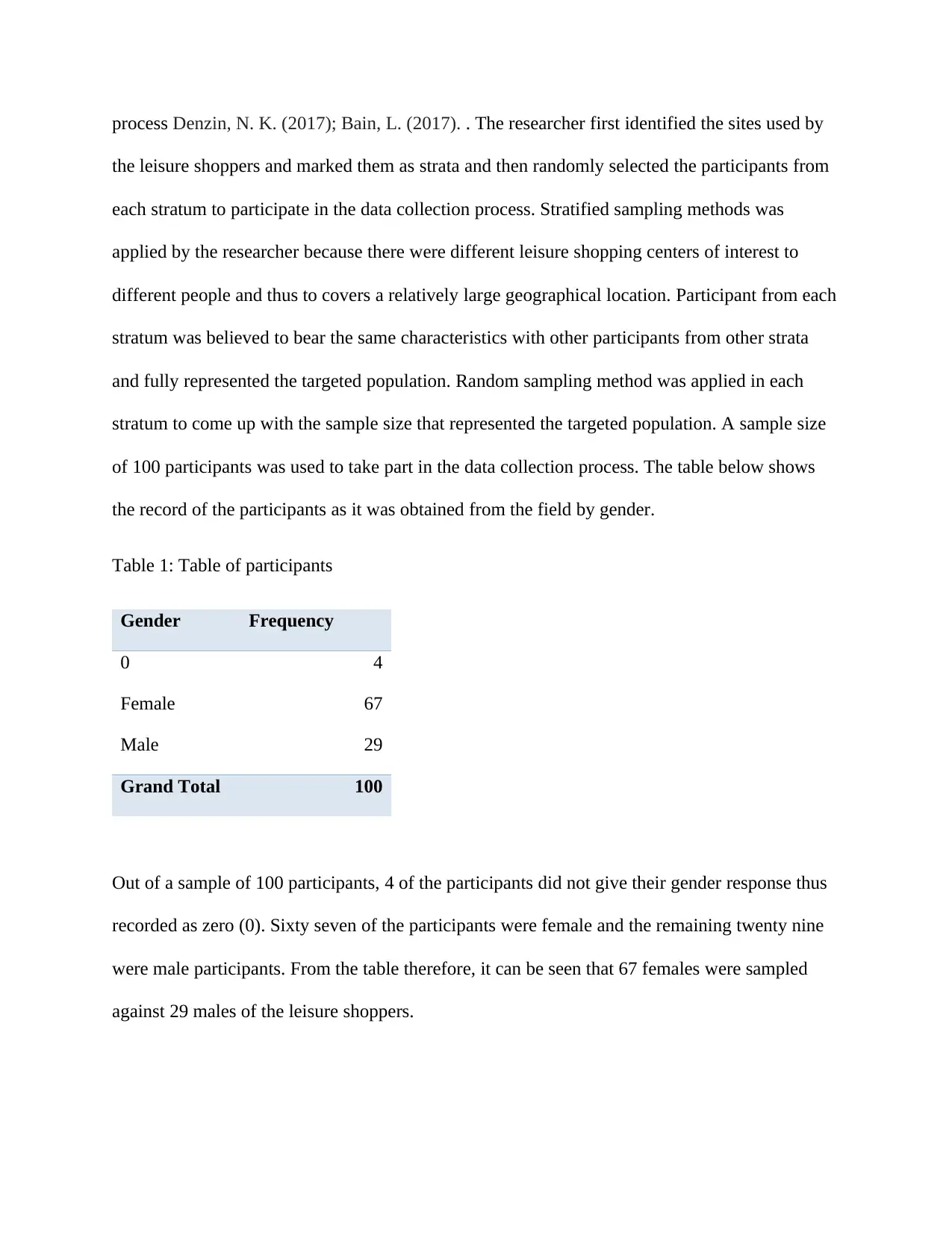
process Denzin, N. K. (2017); Bain, L. (2017). . The researcher first identified the sites used by
the leisure shoppers and marked them as strata and then randomly selected the participants from
each stratum to participate in the data collection process. Stratified sampling methods was
applied by the researcher because there were different leisure shopping centers of interest to
different people and thus to covers a relatively large geographical location. Participant from each
stratum was believed to bear the same characteristics with other participants from other strata
and fully represented the targeted population. Random sampling method was applied in each
stratum to come up with the sample size that represented the targeted population. A sample size
of 100 participants was used to take part in the data collection process. The table below shows
the record of the participants as it was obtained from the field by gender.
Table 1: Table of participants
Gender Frequency
0 4
Female 67
Male 29
Grand Total 100
Out of a sample of 100 participants, 4 of the participants did not give their gender response thus
recorded as zero (0). Sixty seven of the participants were female and the remaining twenty nine
were male participants. From the table therefore, it can be seen that 67 females were sampled
against 29 males of the leisure shoppers.
the leisure shoppers and marked them as strata and then randomly selected the participants from
each stratum to participate in the data collection process. Stratified sampling methods was
applied by the researcher because there were different leisure shopping centers of interest to
different people and thus to covers a relatively large geographical location. Participant from each
stratum was believed to bear the same characteristics with other participants from other strata
and fully represented the targeted population. Random sampling method was applied in each
stratum to come up with the sample size that represented the targeted population. A sample size
of 100 participants was used to take part in the data collection process. The table below shows
the record of the participants as it was obtained from the field by gender.
Table 1: Table of participants
Gender Frequency
0 4
Female 67
Male 29
Grand Total 100
Out of a sample of 100 participants, 4 of the participants did not give their gender response thus
recorded as zero (0). Sixty seven of the participants were female and the remaining twenty nine
were male participants. From the table therefore, it can be seen that 67 females were sampled
against 29 males of the leisure shoppers.
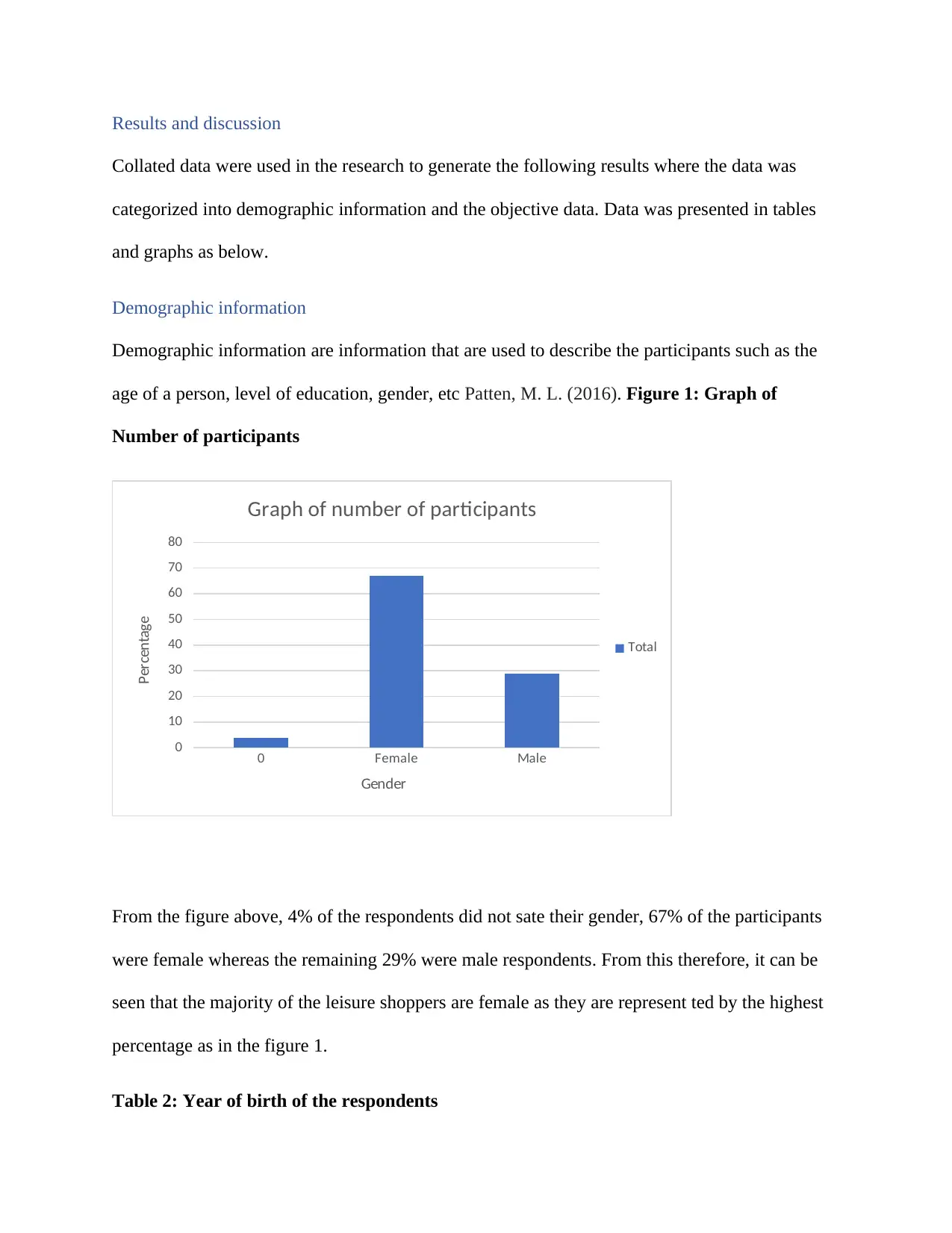
Results and discussion
Collated data were used in the research to generate the following results where the data was
categorized into demographic information and the objective data. Data was presented in tables
and graphs as below.
Demographic information
Demographic information are information that are used to describe the participants such as the
age of a person, level of education, gender, etc Patten, M. L. (2016). Figure 1: Graph of
Number of participants
0 Female Male
0
10
20
30
40
50
60
70
80
Graph of number of participants
Total
Gender
Percentage
From the figure above, 4% of the respondents did not sate their gender, 67% of the participants
were female whereas the remaining 29% were male respondents. From this therefore, it can be
seen that the majority of the leisure shoppers are female as they are represent ted by the highest
percentage as in the figure 1.
Table 2: Year of birth of the respondents
Collated data were used in the research to generate the following results where the data was
categorized into demographic information and the objective data. Data was presented in tables
and graphs as below.
Demographic information
Demographic information are information that are used to describe the participants such as the
age of a person, level of education, gender, etc Patten, M. L. (2016). Figure 1: Graph of
Number of participants
0 Female Male
0
10
20
30
40
50
60
70
80
Graph of number of participants
Total
Gender
Percentage
From the figure above, 4% of the respondents did not sate their gender, 67% of the participants
were female whereas the remaining 29% were male respondents. From this therefore, it can be
seen that the majority of the leisure shoppers are female as they are represent ted by the highest
percentage as in the figure 1.
Table 2: Year of birth of the respondents
Secure Best Marks with AI Grader
Need help grading? Try our AI Grader for instant feedback on your assignments.
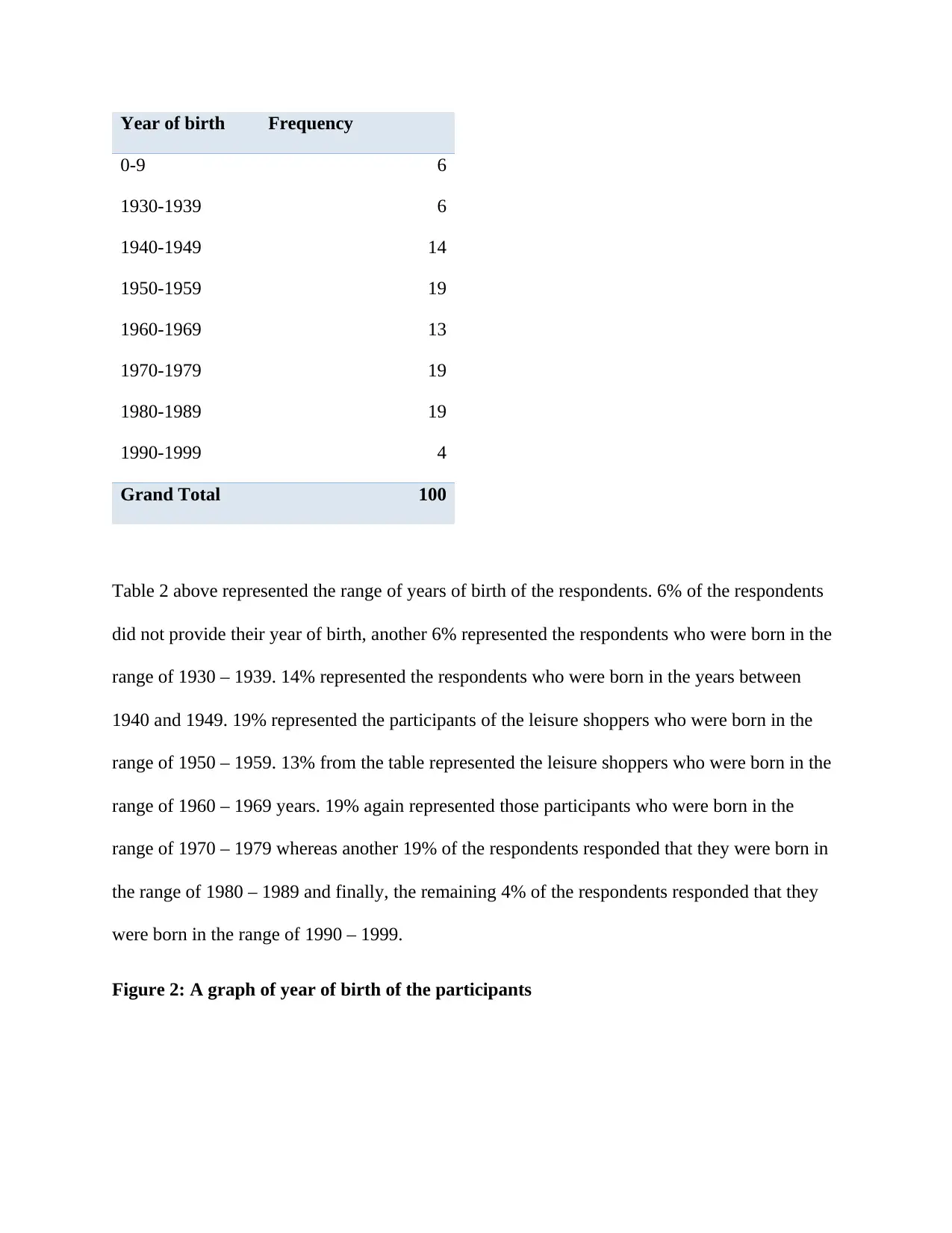
Year of birth Frequency
0-9 6
1930-1939 6
1940-1949 14
1950-1959 19
1960-1969 13
1970-1979 19
1980-1989 19
1990-1999 4
Grand Total 100
Table 2 above represented the range of years of birth of the respondents. 6% of the respondents
did not provide their year of birth, another 6% represented the respondents who were born in the
range of 1930 – 1939. 14% represented the respondents who were born in the years between
1940 and 1949. 19% represented the participants of the leisure shoppers who were born in the
range of 1950 – 1959. 13% from the table represented the leisure shoppers who were born in the
range of 1960 – 1969 years. 19% again represented those participants who were born in the
range of 1970 – 1979 whereas another 19% of the respondents responded that they were born in
the range of 1980 – 1989 and finally, the remaining 4% of the respondents responded that they
were born in the range of 1990 – 1999.
Figure 2: A graph of year of birth of the participants
0-9 6
1930-1939 6
1940-1949 14
1950-1959 19
1960-1969 13
1970-1979 19
1980-1989 19
1990-1999 4
Grand Total 100
Table 2 above represented the range of years of birth of the respondents. 6% of the respondents
did not provide their year of birth, another 6% represented the respondents who were born in the
range of 1930 – 1939. 14% represented the respondents who were born in the years between
1940 and 1949. 19% represented the participants of the leisure shoppers who were born in the
range of 1950 – 1959. 13% from the table represented the leisure shoppers who were born in the
range of 1960 – 1969 years. 19% again represented those participants who were born in the
range of 1970 – 1979 whereas another 19% of the respondents responded that they were born in
the range of 1980 – 1989 and finally, the remaining 4% of the respondents responded that they
were born in the range of 1990 – 1999.
Figure 2: A graph of year of birth of the participants
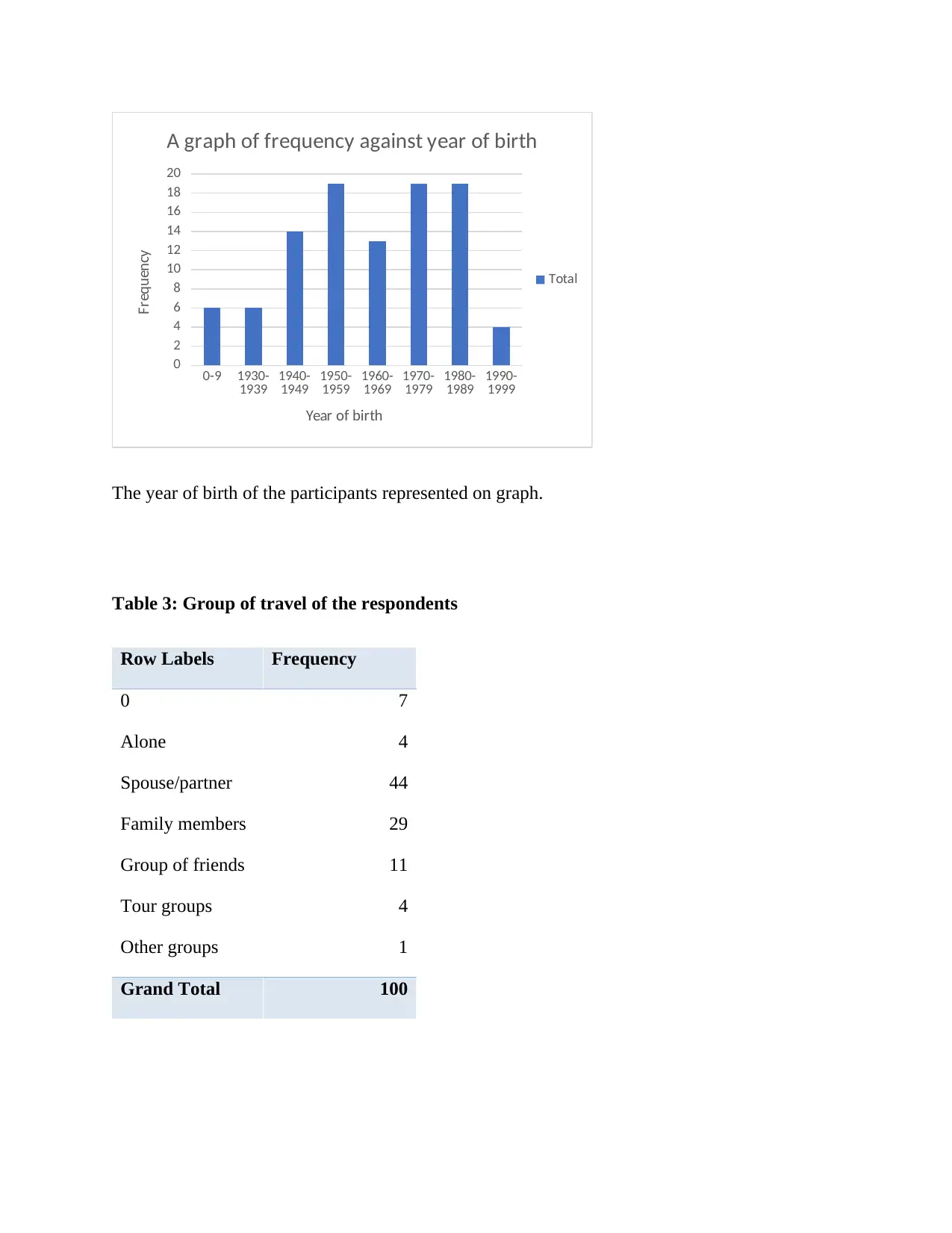
0-9 1930-
1939 1940-
1949 1950-
1959 1960-
1969 1970-
1979 1980-
1989 1990-
1999
0
2
4
6
8
10
12
14
16
18
20
A graph of frequency against year of birth
Total
Year of birth
Frequency
The year of birth of the participants represented on graph.
Table 3: Group of travel of the respondents
Row Labels Frequency
0 7
Alone 4
Spouse/partner 44
Family members 29
Group of friends 11
Tour groups 4
Other groups 1
Grand Total 100
1939 1940-
1949 1950-
1959 1960-
1969 1970-
1979 1980-
1989 1990-
1999
0
2
4
6
8
10
12
14
16
18
20
A graph of frequency against year of birth
Total
Year of birth
Frequency
The year of birth of the participants represented on graph.
Table 3: Group of travel of the respondents
Row Labels Frequency
0 7
Alone 4
Spouse/partner 44
Family members 29
Group of friends 11
Tour groups 4
Other groups 1
Grand Total 100
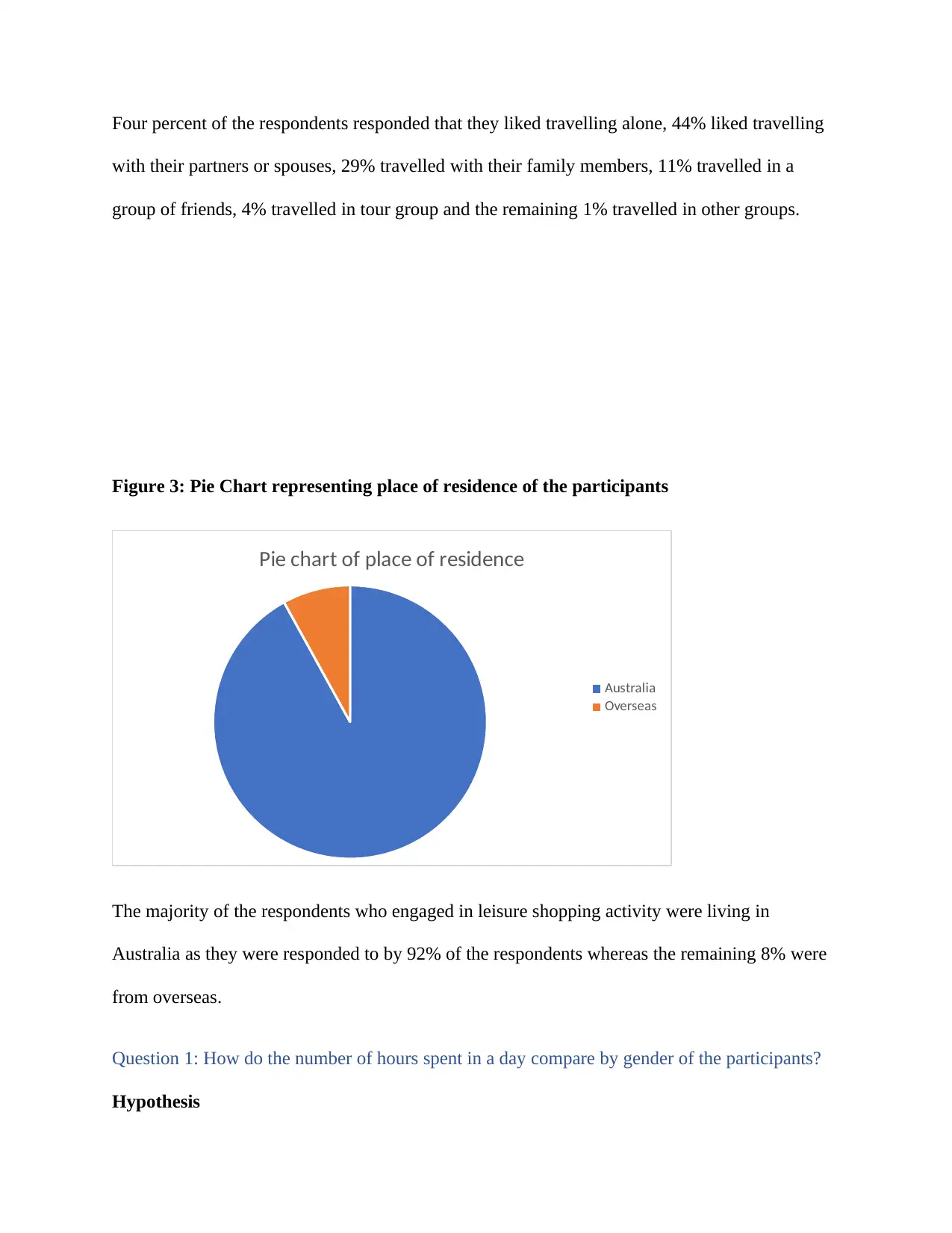
Four percent of the respondents responded that they liked travelling alone, 44% liked travelling
with their partners or spouses, 29% travelled with their family members, 11% travelled in a
group of friends, 4% travelled in tour group and the remaining 1% travelled in other groups.
Figure 3: Pie Chart representing place of residence of the participants
Pie chart of place of residence
Australia
Overseas
The majority of the respondents who engaged in leisure shopping activity were living in
Australia as they were responded to by 92% of the respondents whereas the remaining 8% were
from overseas.
Question 1: How do the number of hours spent in a day compare by gender of the participants?
Hypothesis
with their partners or spouses, 29% travelled with their family members, 11% travelled in a
group of friends, 4% travelled in tour group and the remaining 1% travelled in other groups.
Figure 3: Pie Chart representing place of residence of the participants
Pie chart of place of residence
Australia
Overseas
The majority of the respondents who engaged in leisure shopping activity were living in
Australia as they were responded to by 92% of the respondents whereas the remaining 8% were
from overseas.
Question 1: How do the number of hours spent in a day compare by gender of the participants?
Hypothesis
Paraphrase This Document
Need a fresh take? Get an instant paraphrase of this document with our AI Paraphraser

H0: There is significant difference in mean number of hours spent by male travelers on leisure
shopping during day and the mean numbers of hours spent by female travelers.
H1: There is no significant difference in the mean number of hours spent by male travelers on
leisure shopping during day and the mean number of hours spent by female travelers.
Table 4: t-Test: Two-Sample Assuming Equal Variances
male hours female hour
Mean 1.681034483 1.962686567
Variance 2.691502463 3.206919946
Observations 29 67
Pooled Variance 3.053391334
Hypothesized Mean Difference 0
df 94
t Stat -0.725141097
P(T<=t) one-tail 0.235083403
t Critical one-tail 1.661225855
P(T<=t) two-tail 0.470166805
t Critical two-tail 1.985523442
In the test of hypothesis for the mean number of hours spent by male and female travelers on
leisure shopping during the day, the t-test statistic was -0.725141097 and t critical two tail was
1.985523442. Since t-test statistic was less than t-critical and P-value (0.470166805) was greater
than significant P-value (0.05), we fail to reject the null hypothesis and thus conclude that there
was significant difference in mean number of hours spent by spent by male travelers on leisure
shopping during day and the mean number of hours spent by female travelers on leisure
shopping.
Figure 4: Average hours against gender
shopping during day and the mean numbers of hours spent by female travelers.
H1: There is no significant difference in the mean number of hours spent by male travelers on
leisure shopping during day and the mean number of hours spent by female travelers.
Table 4: t-Test: Two-Sample Assuming Equal Variances
male hours female hour
Mean 1.681034483 1.962686567
Variance 2.691502463 3.206919946
Observations 29 67
Pooled Variance 3.053391334
Hypothesized Mean Difference 0
df 94
t Stat -0.725141097
P(T<=t) one-tail 0.235083403
t Critical one-tail 1.661225855
P(T<=t) two-tail 0.470166805
t Critical two-tail 1.985523442
In the test of hypothesis for the mean number of hours spent by male and female travelers on
leisure shopping during the day, the t-test statistic was -0.725141097 and t critical two tail was
1.985523442. Since t-test statistic was less than t-critical and P-value (0.470166805) was greater
than significant P-value (0.05), we fail to reject the null hypothesis and thus conclude that there
was significant difference in mean number of hours spent by spent by male travelers on leisure
shopping during day and the mean number of hours spent by female travelers on leisure
shopping.
Figure 4: Average hours against gender
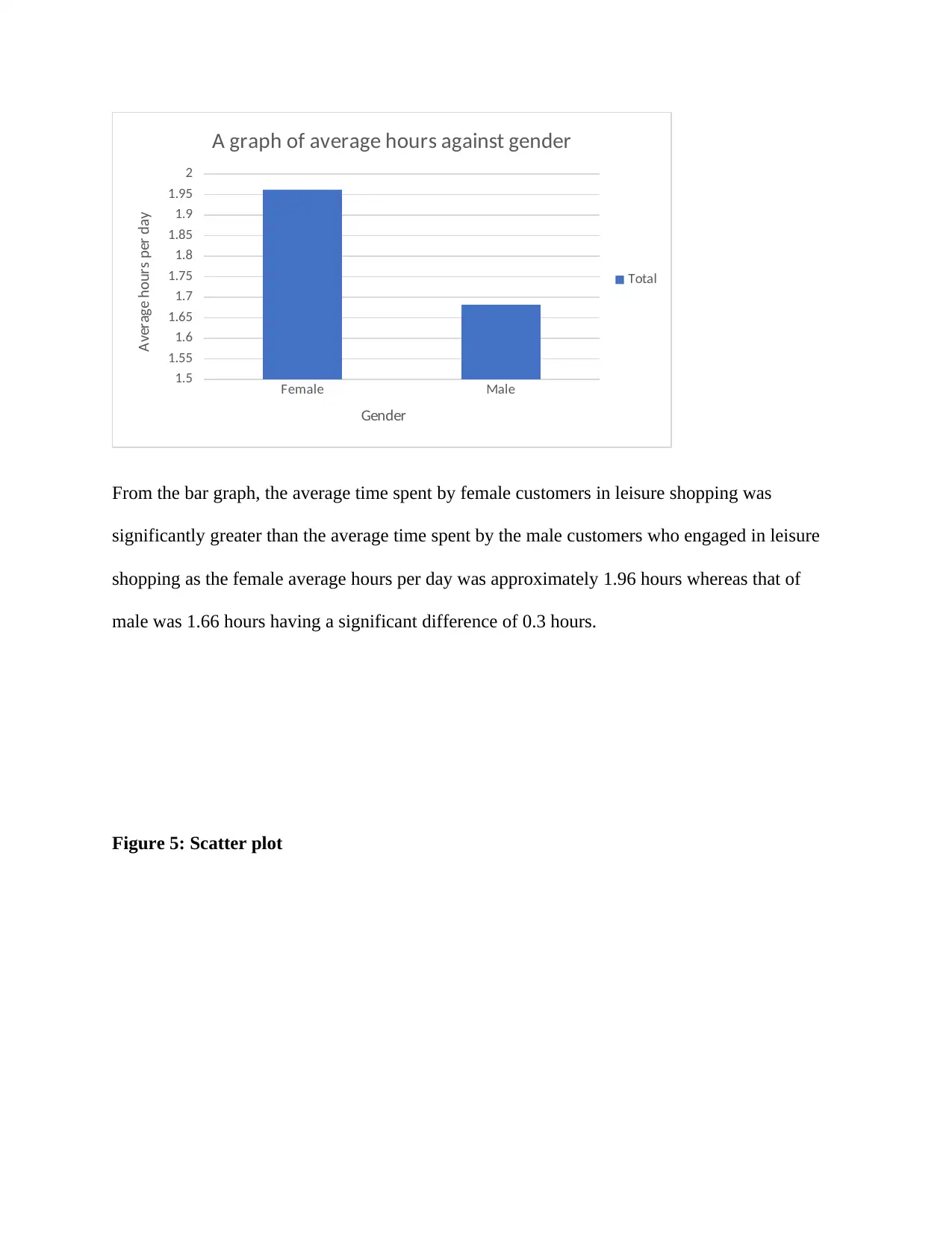
Female Male
1.5
1.55
1.6
1.65
1.7
1.75
1.8
1.85
1.9
1.95
2
A graph of average hours against gender
Total
Gender
Average hours per day
From the bar graph, the average time spent by female customers in leisure shopping was
significantly greater than the average time spent by the male customers who engaged in leisure
shopping as the female average hours per day was approximately 1.96 hours whereas that of
male was 1.66 hours having a significant difference of 0.3 hours.
Figure 5: Scatter plot
1.5
1.55
1.6
1.65
1.7
1.75
1.8
1.85
1.9
1.95
2
A graph of average hours against gender
Total
Gender
Average hours per day
From the bar graph, the average time spent by female customers in leisure shopping was
significantly greater than the average time spent by the male customers who engaged in leisure
shopping as the female average hours per day was approximately 1.96 hours whereas that of
male was 1.66 hours having a significant difference of 0.3 hours.
Figure 5: Scatter plot
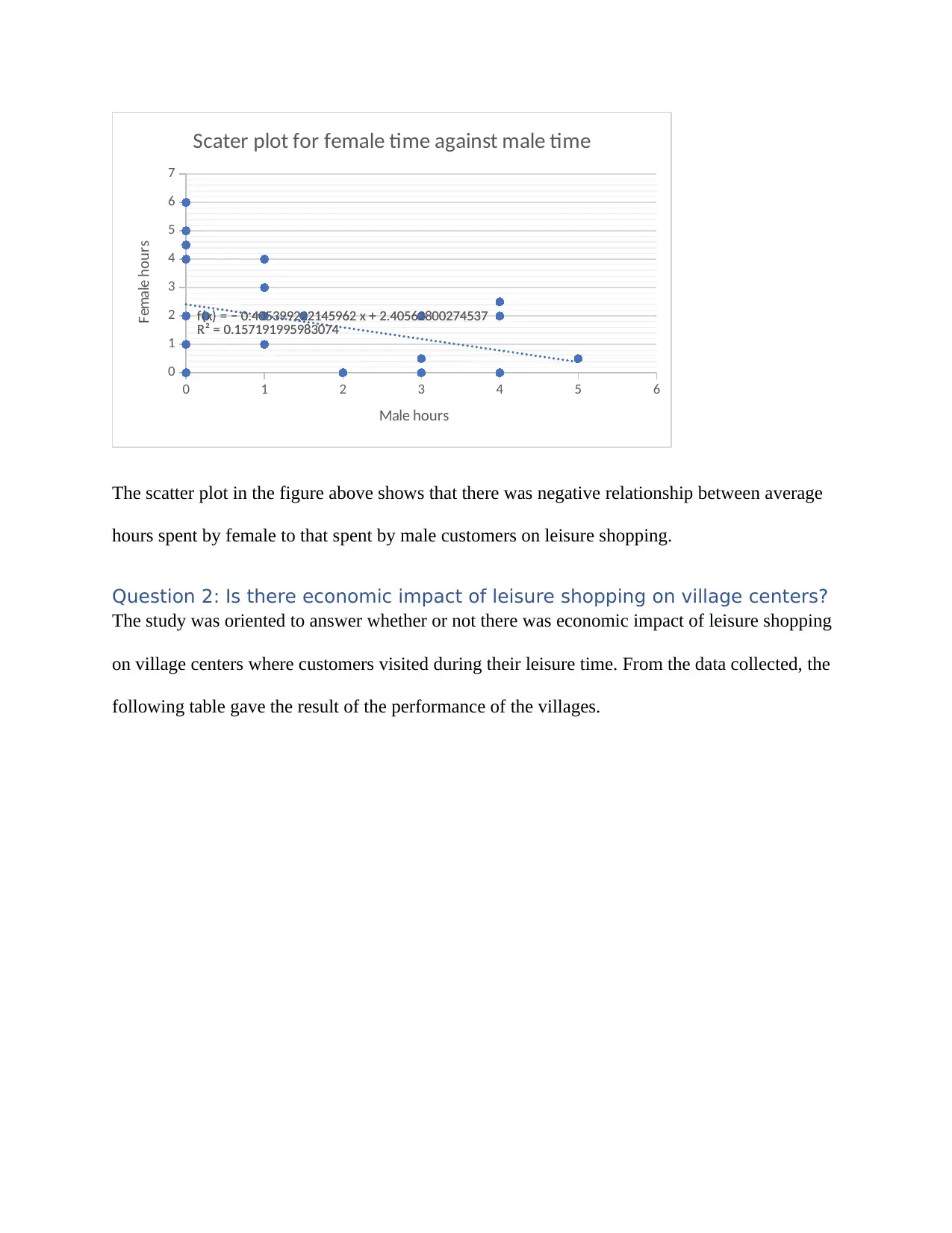
0 1 2 3 4 5 6
0
1
2
3
4
5
6
7
f(x) = − 0.405399222145962 x + 2.40562800274537
R² = 0.157191995983074
f(x) = − 0.405399222145962 x + 2.40562800274537
R² = 0.157191995983074
Scater plot for female time against male time
Male hours
Female hours
The scatter plot in the figure above shows that there was negative relationship between average
hours spent by female to that spent by male customers on leisure shopping.
Question 2: Is there economic impact of leisure shopping on village centers?
The study was oriented to answer whether or not there was economic impact of leisure shopping
on village centers where customers visited during their leisure time. From the data collected, the
following table gave the result of the performance of the villages.
0
1
2
3
4
5
6
7
f(x) = − 0.405399222145962 x + 2.40562800274537
R² = 0.157191995983074
f(x) = − 0.405399222145962 x + 2.40562800274537
R² = 0.157191995983074
Scater plot for female time against male time
Male hours
Female hours
The scatter plot in the figure above shows that there was negative relationship between average
hours spent by female to that spent by male customers on leisure shopping.
Question 2: Is there economic impact of leisure shopping on village centers?
The study was oriented to answer whether or not there was economic impact of leisure shopping
on village centers where customers visited during their leisure time. From the data collected, the
following table gave the result of the performance of the villages.
Secure Best Marks with AI Grader
Need help grading? Try our AI Grader for instant feedback on your assignments.
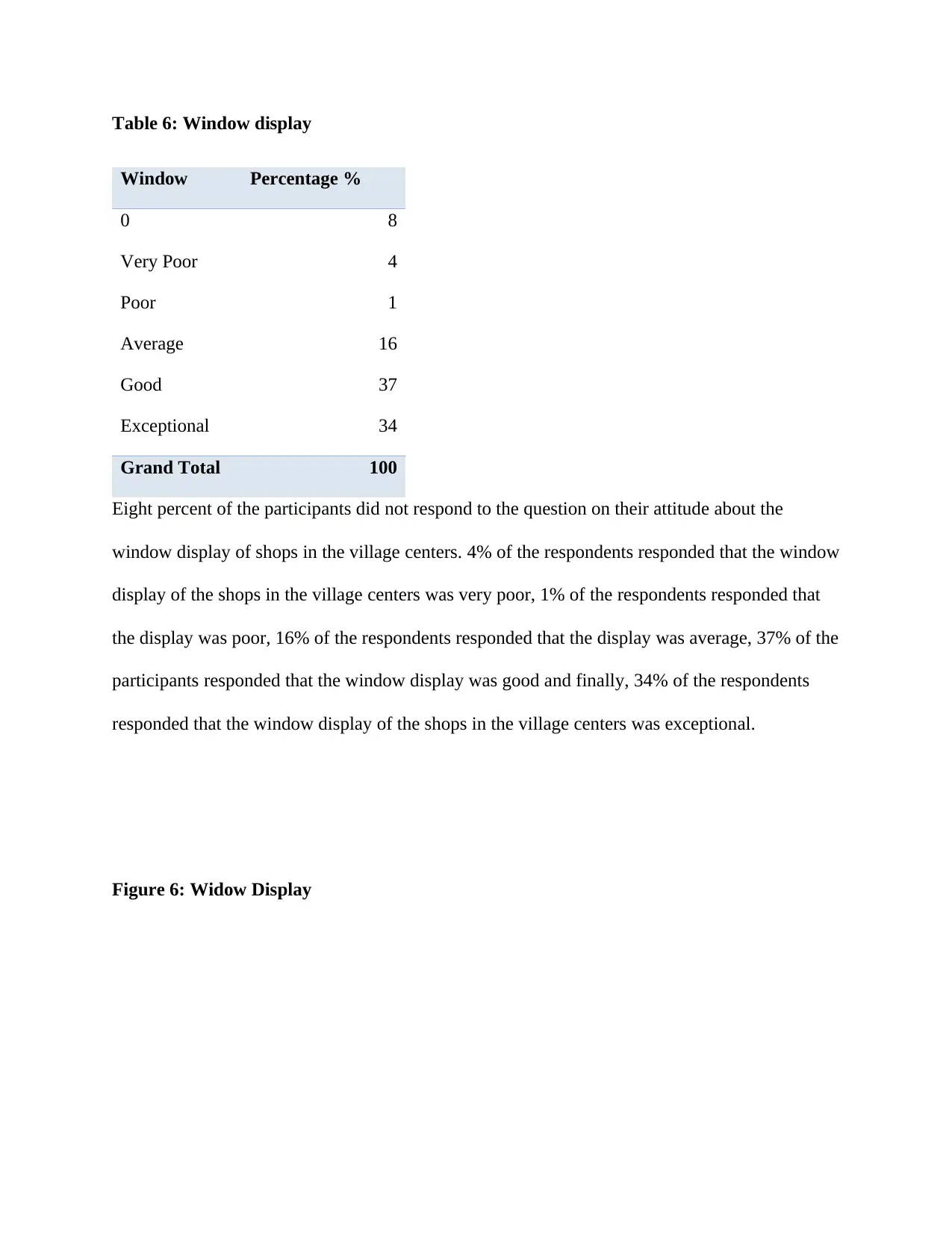
Table 6: Window display
Window Percentage %
0 8
Very Poor 4
Poor 1
Average 16
Good 37
Exceptional 34
Grand Total 100
Eight percent of the participants did not respond to the question on their attitude about the
window display of shops in the village centers. 4% of the respondents responded that the window
display of the shops in the village centers was very poor, 1% of the respondents responded that
the display was poor, 16% of the respondents responded that the display was average, 37% of the
participants responded that the window display was good and finally, 34% of the respondents
responded that the window display of the shops in the village centers was exceptional.
Figure 6: Widow Display
Window Percentage %
0 8
Very Poor 4
Poor 1
Average 16
Good 37
Exceptional 34
Grand Total 100
Eight percent of the participants did not respond to the question on their attitude about the
window display of shops in the village centers. 4% of the respondents responded that the window
display of the shops in the village centers was very poor, 1% of the respondents responded that
the display was poor, 16% of the respondents responded that the display was average, 37% of the
participants responded that the window display was good and finally, 34% of the respondents
responded that the window display of the shops in the village centers was exceptional.
Figure 6: Widow Display
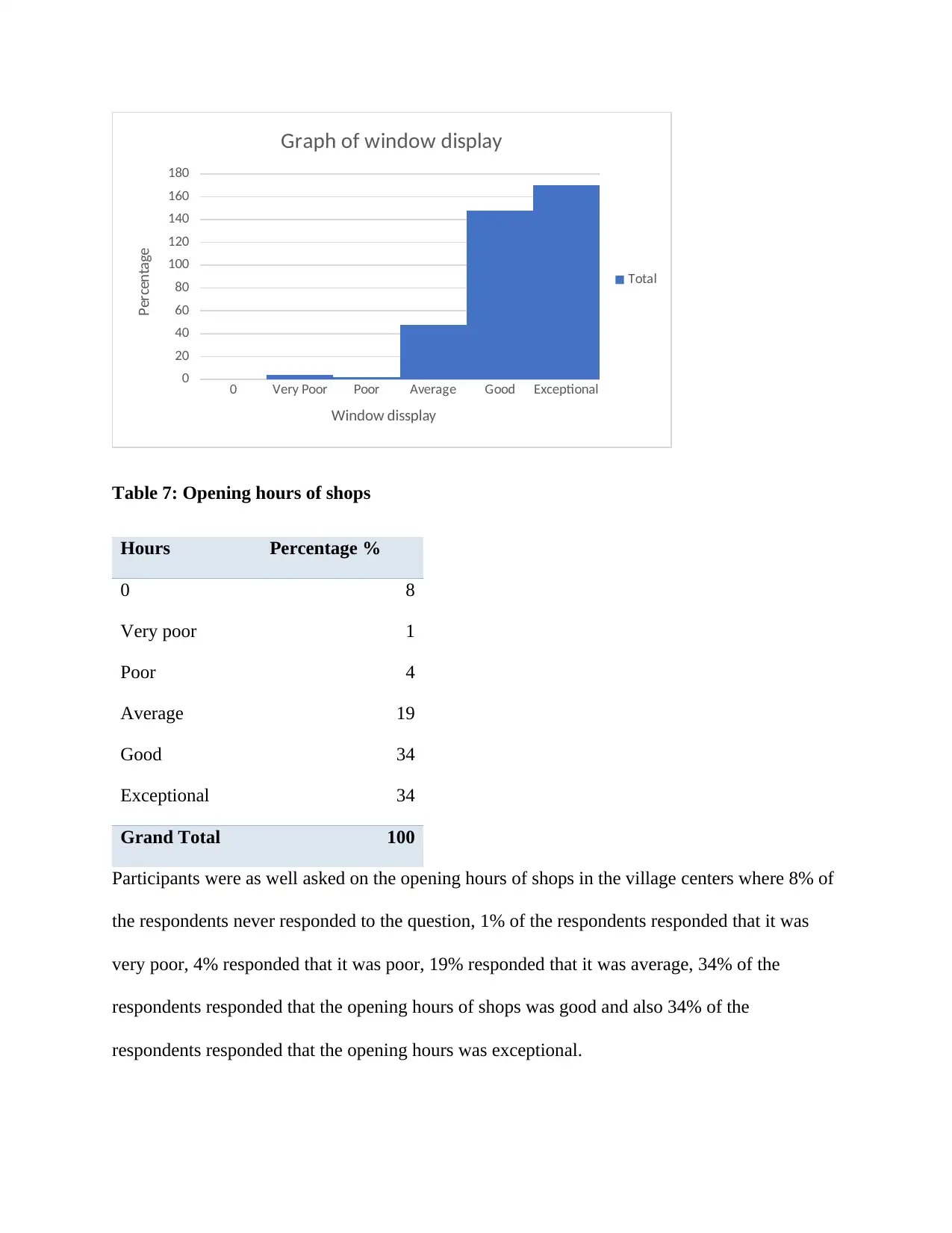
0 Very Poor Poor Average Good Exceptional
0
20
40
60
80
100
120
140
160
180
Graph of window display
Total
Window dissplay
Percentage
Table 7: Opening hours of shops
Hours Percentage %
0 8
Very poor 1
Poor 4
Average 19
Good 34
Exceptional 34
Grand Total 100
Participants were as well asked on the opening hours of shops in the village centers where 8% of
the respondents never responded to the question, 1% of the respondents responded that it was
very poor, 4% responded that it was poor, 19% responded that it was average, 34% of the
respondents responded that the opening hours of shops was good and also 34% of the
respondents responded that the opening hours was exceptional.
0
20
40
60
80
100
120
140
160
180
Graph of window display
Total
Window dissplay
Percentage
Table 7: Opening hours of shops
Hours Percentage %
0 8
Very poor 1
Poor 4
Average 19
Good 34
Exceptional 34
Grand Total 100
Participants were as well asked on the opening hours of shops in the village centers where 8% of
the respondents never responded to the question, 1% of the respondents responded that it was
very poor, 4% responded that it was poor, 19% responded that it was average, 34% of the
respondents responded that the opening hours of shops was good and also 34% of the
respondents responded that the opening hours was exceptional.

Limitations
These were the shortcomings of this study that are encountered in the entire research process.
This research has a number of limitations such as the research methodology. Correlational design
that was employed in this research study led to investigation of the relationship between mean
hours spent by male and female during the day while on leisure shopping where negative
relationship was found to be existing. The cause of negative relationship between the tested
variables was not revealed by the correlational analysis. This can in future be avoided by
carrying out ANOVA and conducting post hoc analysis e advanced statistical tools using which
will help in identifying the cause of effect. Furthermore the inferences that were made from the
correlational analysis could sometimes be deceptive and thus not reliable. In future such
problems can be avoided by incorporating post hoc analysis for reliable results.
Another limitation that was encountered by the researcher was in data collection method. The
data collection technique that was employed by the researcher was use of questionnaires and
surveys. Despite the popularity it has among the researchers, it has limitations that could affect
results. Being that questionnaires are structured, they allow for little flexibility to the participants
in regard to the response format. Particularly in the case where closed ended questions are used
in the questionnaire in the research, the participants could have different response to the ones
provided in the multiple choices but they do not have any other choice other than working with
the available choices. In this research most of the questions used were closed ended questions
with multiple choices from which the respondents were required to choose from, it thus lacked
flexibility which made some of the respondents not express their feelings fully. This can in future
be avoided by structuring open ended questions that enable the respondents to provide responses
as per their feelings to the questions presented to them.
These were the shortcomings of this study that are encountered in the entire research process.
This research has a number of limitations such as the research methodology. Correlational design
that was employed in this research study led to investigation of the relationship between mean
hours spent by male and female during the day while on leisure shopping where negative
relationship was found to be existing. The cause of negative relationship between the tested
variables was not revealed by the correlational analysis. This can in future be avoided by
carrying out ANOVA and conducting post hoc analysis e advanced statistical tools using which
will help in identifying the cause of effect. Furthermore the inferences that were made from the
correlational analysis could sometimes be deceptive and thus not reliable. In future such
problems can be avoided by incorporating post hoc analysis for reliable results.
Another limitation that was encountered by the researcher was in data collection method. The
data collection technique that was employed by the researcher was use of questionnaires and
surveys. Despite the popularity it has among the researchers, it has limitations that could affect
results. Being that questionnaires are structured, they allow for little flexibility to the participants
in regard to the response format. Particularly in the case where closed ended questions are used
in the questionnaire in the research, the participants could have different response to the ones
provided in the multiple choices but they do not have any other choice other than working with
the available choices. In this research most of the questions used were closed ended questions
with multiple choices from which the respondents were required to choose from, it thus lacked
flexibility which made some of the respondents not express their feelings fully. This can in future
be avoided by structuring open ended questions that enable the respondents to provide responses
as per their feelings to the questions presented to them.
Paraphrase This Document
Need a fresh take? Get an instant paraphrase of this document with our AI Paraphraser
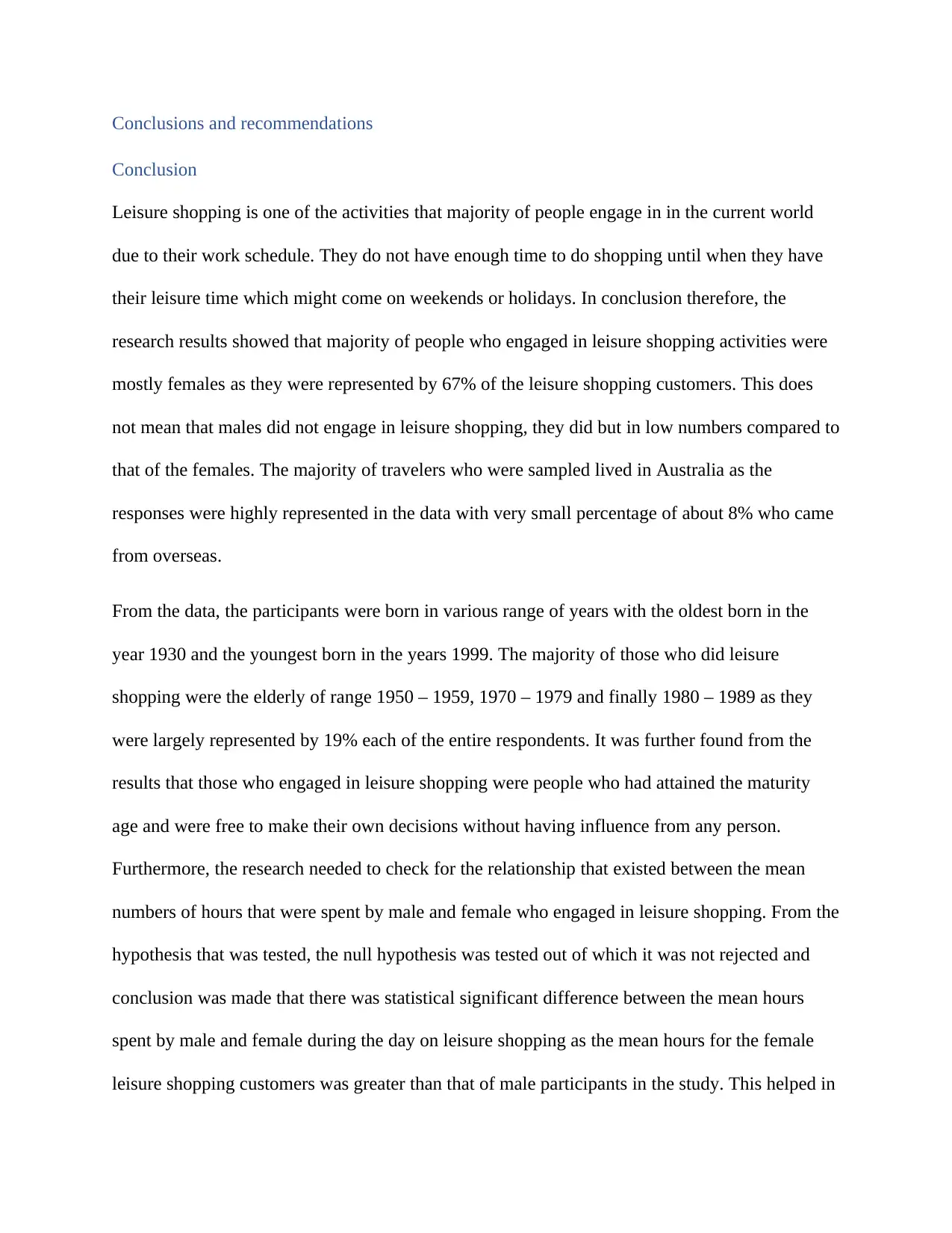
Conclusions and recommendations
Conclusion
Leisure shopping is one of the activities that majority of people engage in in the current world
due to their work schedule. They do not have enough time to do shopping until when they have
their leisure time which might come on weekends or holidays. In conclusion therefore, the
research results showed that majority of people who engaged in leisure shopping activities were
mostly females as they were represented by 67% of the leisure shopping customers. This does
not mean that males did not engage in leisure shopping, they did but in low numbers compared to
that of the females. The majority of travelers who were sampled lived in Australia as the
responses were highly represented in the data with very small percentage of about 8% who came
from overseas.
From the data, the participants were born in various range of years with the oldest born in the
year 1930 and the youngest born in the years 1999. The majority of those who did leisure
shopping were the elderly of range 1950 – 1959, 1970 – 1979 and finally 1980 – 1989 as they
were largely represented by 19% each of the entire respondents. It was further found from the
results that those who engaged in leisure shopping were people who had attained the maturity
age and were free to make their own decisions without having influence from any person.
Furthermore, the research needed to check for the relationship that existed between the mean
numbers of hours that were spent by male and female who engaged in leisure shopping. From the
hypothesis that was tested, the null hypothesis was tested out of which it was not rejected and
conclusion was made that there was statistical significant difference between the mean hours
spent by male and female during the day on leisure shopping as the mean hours for the female
leisure shopping customers was greater than that of male participants in the study. This helped in
Conclusion
Leisure shopping is one of the activities that majority of people engage in in the current world
due to their work schedule. They do not have enough time to do shopping until when they have
their leisure time which might come on weekends or holidays. In conclusion therefore, the
research results showed that majority of people who engaged in leisure shopping activities were
mostly females as they were represented by 67% of the leisure shopping customers. This does
not mean that males did not engage in leisure shopping, they did but in low numbers compared to
that of the females. The majority of travelers who were sampled lived in Australia as the
responses were highly represented in the data with very small percentage of about 8% who came
from overseas.
From the data, the participants were born in various range of years with the oldest born in the
year 1930 and the youngest born in the years 1999. The majority of those who did leisure
shopping were the elderly of range 1950 – 1959, 1970 – 1979 and finally 1980 – 1989 as they
were largely represented by 19% each of the entire respondents. It was further found from the
results that those who engaged in leisure shopping were people who had attained the maturity
age and were free to make their own decisions without having influence from any person.
Furthermore, the research needed to check for the relationship that existed between the mean
numbers of hours that were spent by male and female who engaged in leisure shopping. From the
hypothesis that was tested, the null hypothesis was tested out of which it was not rejected and
conclusion was made that there was statistical significant difference between the mean hours
spent by male and female during the day on leisure shopping as the mean hours for the female
leisure shopping customers was greater than that of male participants in the study. This helped in
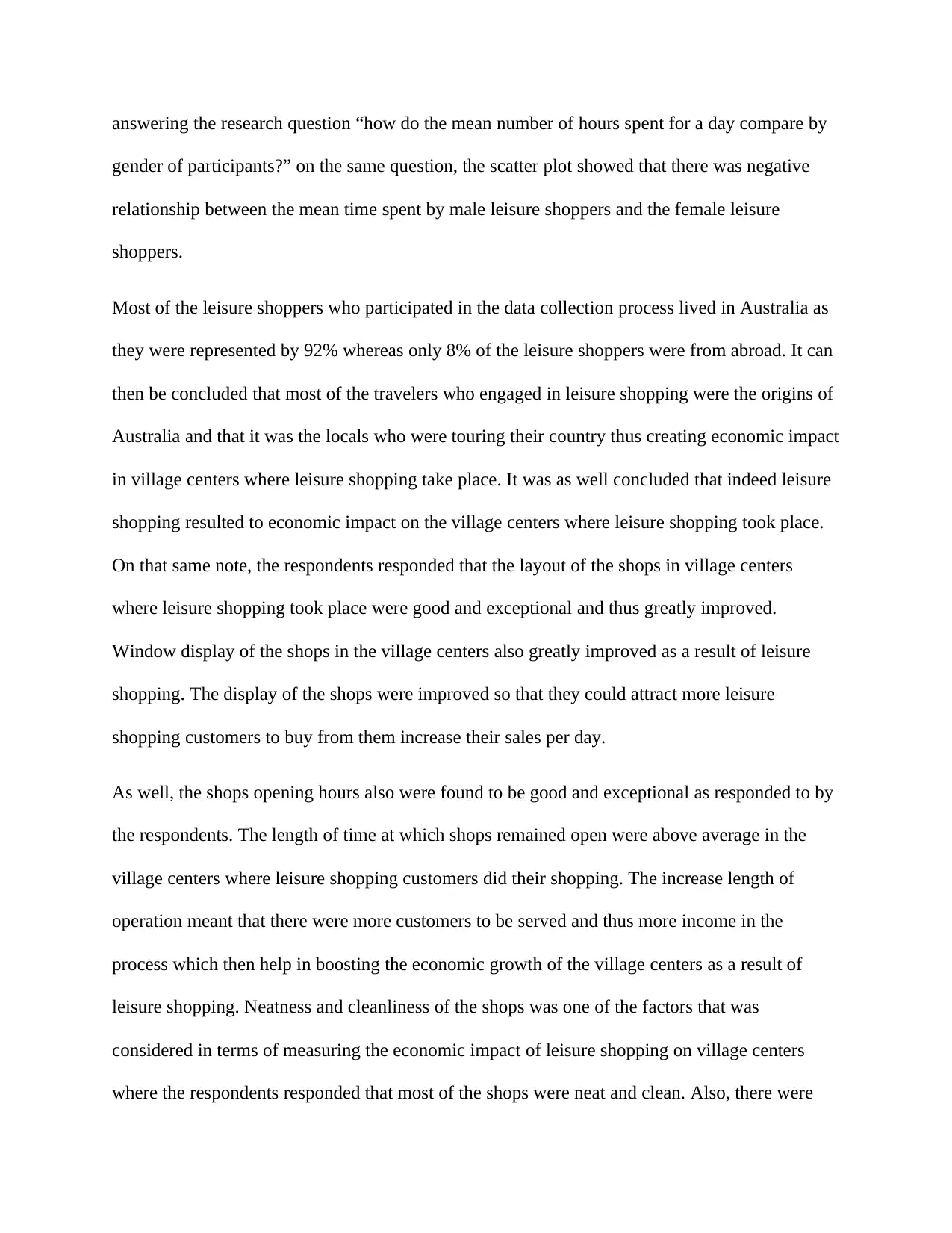
answering the research question “how do the mean number of hours spent for a day compare by
gender of participants?” on the same question, the scatter plot showed that there was negative
relationship between the mean time spent by male leisure shoppers and the female leisure
shoppers.
Most of the leisure shoppers who participated in the data collection process lived in Australia as
they were represented by 92% whereas only 8% of the leisure shoppers were from abroad. It can
then be concluded that most of the travelers who engaged in leisure shopping were the origins of
Australia and that it was the locals who were touring their country thus creating economic impact
in village centers where leisure shopping take place. It was as well concluded that indeed leisure
shopping resulted to economic impact on the village centers where leisure shopping took place.
On that same note, the respondents responded that the layout of the shops in village centers
where leisure shopping took place were good and exceptional and thus greatly improved.
Window display of the shops in the village centers also greatly improved as a result of leisure
shopping. The display of the shops were improved so that they could attract more leisure
shopping customers to buy from them increase their sales per day.
As well, the shops opening hours also were found to be good and exceptional as responded to by
the respondents. The length of time at which shops remained open were above average in the
village centers where leisure shopping customers did their shopping. The increase length of
operation meant that there were more customers to be served and thus more income in the
process which then help in boosting the economic growth of the village centers as a result of
leisure shopping. Neatness and cleanliness of the shops was one of the factors that was
considered in terms of measuring the economic impact of leisure shopping on village centers
where the respondents responded that most of the shops were neat and clean. Also, there were
gender of participants?” on the same question, the scatter plot showed that there was negative
relationship between the mean time spent by male leisure shoppers and the female leisure
shoppers.
Most of the leisure shoppers who participated in the data collection process lived in Australia as
they were represented by 92% whereas only 8% of the leisure shoppers were from abroad. It can
then be concluded that most of the travelers who engaged in leisure shopping were the origins of
Australia and that it was the locals who were touring their country thus creating economic impact
in village centers where leisure shopping take place. It was as well concluded that indeed leisure
shopping resulted to economic impact on the village centers where leisure shopping took place.
On that same note, the respondents responded that the layout of the shops in village centers
where leisure shopping took place were good and exceptional and thus greatly improved.
Window display of the shops in the village centers also greatly improved as a result of leisure
shopping. The display of the shops were improved so that they could attract more leisure
shopping customers to buy from them increase their sales per day.
As well, the shops opening hours also were found to be good and exceptional as responded to by
the respondents. The length of time at which shops remained open were above average in the
village centers where leisure shopping customers did their shopping. The increase length of
operation meant that there were more customers to be served and thus more income in the
process which then help in boosting the economic growth of the village centers as a result of
leisure shopping. Neatness and cleanliness of the shops was one of the factors that was
considered in terms of measuring the economic impact of leisure shopping on village centers
where the respondents responded that most of the shops were neat and clean. Also, there were
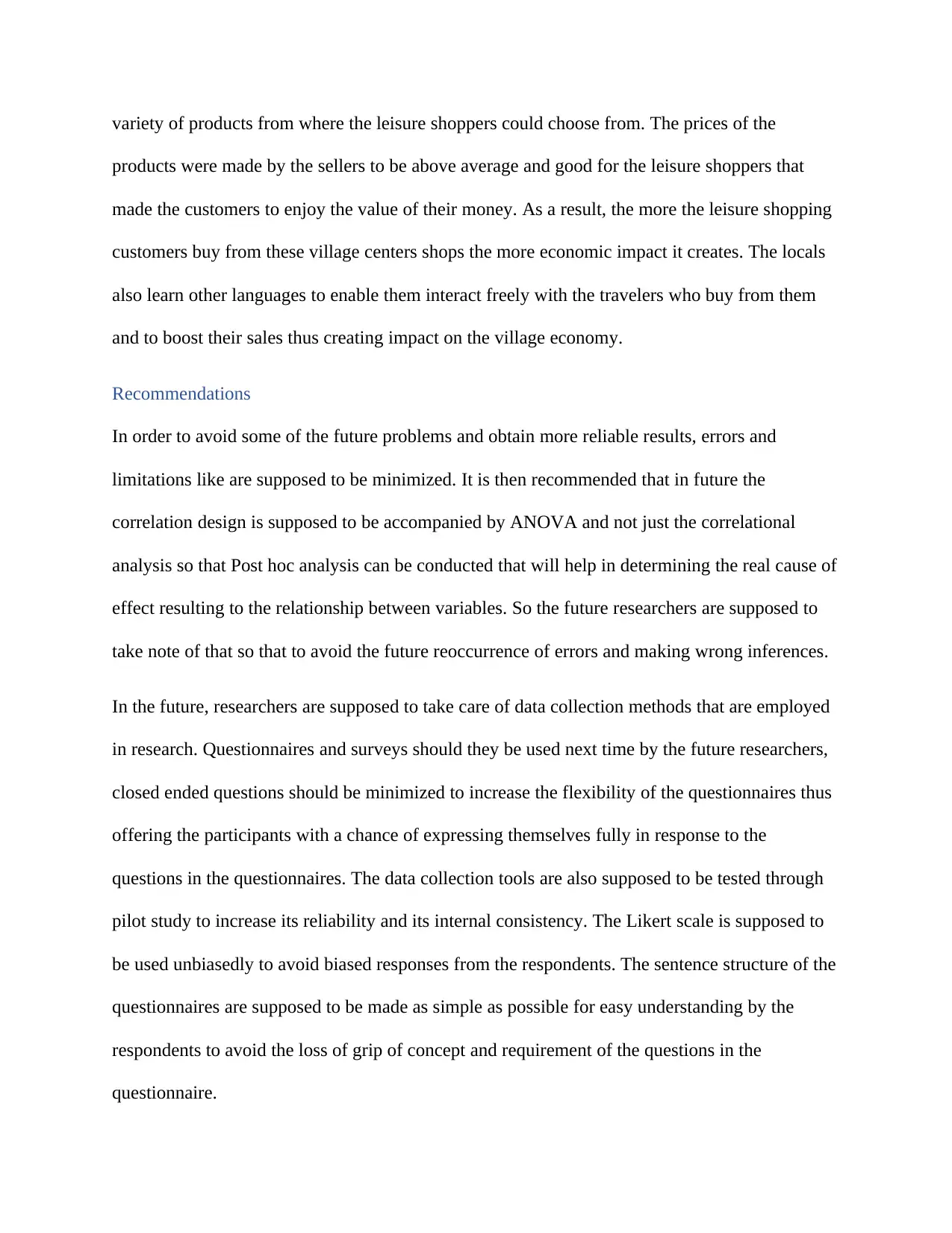
variety of products from where the leisure shoppers could choose from. The prices of the
products were made by the sellers to be above average and good for the leisure shoppers that
made the customers to enjoy the value of their money. As a result, the more the leisure shopping
customers buy from these village centers shops the more economic impact it creates. The locals
also learn other languages to enable them interact freely with the travelers who buy from them
and to boost their sales thus creating impact on the village economy.
Recommendations
In order to avoid some of the future problems and obtain more reliable results, errors and
limitations like are supposed to be minimized. It is then recommended that in future the
correlation design is supposed to be accompanied by ANOVA and not just the correlational
analysis so that Post hoc analysis can be conducted that will help in determining the real cause of
effect resulting to the relationship between variables. So the future researchers are supposed to
take note of that so that to avoid the future reoccurrence of errors and making wrong inferences.
In the future, researchers are supposed to take care of data collection methods that are employed
in research. Questionnaires and surveys should they be used next time by the future researchers,
closed ended questions should be minimized to increase the flexibility of the questionnaires thus
offering the participants with a chance of expressing themselves fully in response to the
questions in the questionnaires. The data collection tools are also supposed to be tested through
pilot study to increase its reliability and its internal consistency. The Likert scale is supposed to
be used unbiasedly to avoid biased responses from the respondents. The sentence structure of the
questionnaires are supposed to be made as simple as possible for easy understanding by the
respondents to avoid the loss of grip of concept and requirement of the questions in the
questionnaire.
products were made by the sellers to be above average and good for the leisure shoppers that
made the customers to enjoy the value of their money. As a result, the more the leisure shopping
customers buy from these village centers shops the more economic impact it creates. The locals
also learn other languages to enable them interact freely with the travelers who buy from them
and to boost their sales thus creating impact on the village economy.
Recommendations
In order to avoid some of the future problems and obtain more reliable results, errors and
limitations like are supposed to be minimized. It is then recommended that in future the
correlation design is supposed to be accompanied by ANOVA and not just the correlational
analysis so that Post hoc analysis can be conducted that will help in determining the real cause of
effect resulting to the relationship between variables. So the future researchers are supposed to
take note of that so that to avoid the future reoccurrence of errors and making wrong inferences.
In the future, researchers are supposed to take care of data collection methods that are employed
in research. Questionnaires and surveys should they be used next time by the future researchers,
closed ended questions should be minimized to increase the flexibility of the questionnaires thus
offering the participants with a chance of expressing themselves fully in response to the
questions in the questionnaires. The data collection tools are also supposed to be tested through
pilot study to increase its reliability and its internal consistency. The Likert scale is supposed to
be used unbiasedly to avoid biased responses from the respondents. The sentence structure of the
questionnaires are supposed to be made as simple as possible for easy understanding by the
respondents to avoid the loss of grip of concept and requirement of the questions in the
questionnaire.
Secure Best Marks with AI Grader
Need help grading? Try our AI Grader for instant feedback on your assignments.
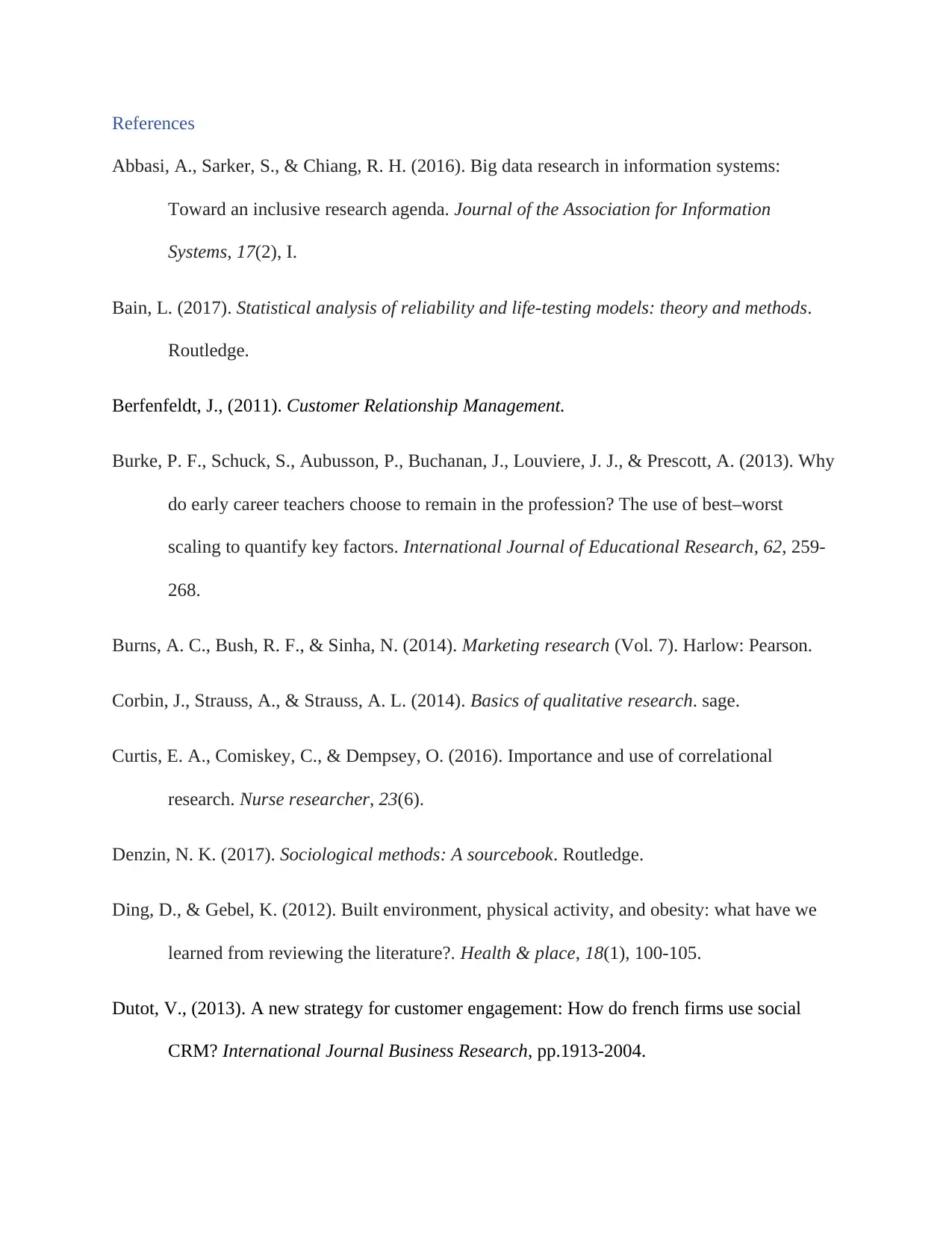
References
Abbasi, A., Sarker, S., & Chiang, R. H. (2016). Big data research in information systems:
Toward an inclusive research agenda. Journal of the Association for Information
Systems, 17(2), I.
Bain, L. (2017). Statistical analysis of reliability and life-testing models: theory and methods.
Routledge.
Berfenfeldt, J., (2011). Customer Relationship Management.
Burke, P. F., Schuck, S., Aubusson, P., Buchanan, J., Louviere, J. J., & Prescott, A. (2013). Why
do early career teachers choose to remain in the profession? The use of best–worst
scaling to quantify key factors. International Journal of Educational Research, 62, 259-
268.
Burns, A. C., Bush, R. F., & Sinha, N. (2014). Marketing research (Vol. 7). Harlow: Pearson.
Corbin, J., Strauss, A., & Strauss, A. L. (2014). Basics of qualitative research. sage.
Curtis, E. A., Comiskey, C., & Dempsey, O. (2016). Importance and use of correlational
research. Nurse researcher, 23(6).
Denzin, N. K. (2017). Sociological methods: A sourcebook. Routledge.
Ding, D., & Gebel, K. (2012). Built environment, physical activity, and obesity: what have we
learned from reviewing the literature?. Health & place, 18(1), 100-105.
Dutot, V., (2013). A new strategy for customer engagement: How do french firms use social
CRM? International Journal Business Research, pp.1913-2004.
Abbasi, A., Sarker, S., & Chiang, R. H. (2016). Big data research in information systems:
Toward an inclusive research agenda. Journal of the Association for Information
Systems, 17(2), I.
Bain, L. (2017). Statistical analysis of reliability and life-testing models: theory and methods.
Routledge.
Berfenfeldt, J., (2011). Customer Relationship Management.
Burke, P. F., Schuck, S., Aubusson, P., Buchanan, J., Louviere, J. J., & Prescott, A. (2013). Why
do early career teachers choose to remain in the profession? The use of best–worst
scaling to quantify key factors. International Journal of Educational Research, 62, 259-
268.
Burns, A. C., Bush, R. F., & Sinha, N. (2014). Marketing research (Vol. 7). Harlow: Pearson.
Corbin, J., Strauss, A., & Strauss, A. L. (2014). Basics of qualitative research. sage.
Curtis, E. A., Comiskey, C., & Dempsey, O. (2016). Importance and use of correlational
research. Nurse researcher, 23(6).
Denzin, N. K. (2017). Sociological methods: A sourcebook. Routledge.
Ding, D., & Gebel, K. (2012). Built environment, physical activity, and obesity: what have we
learned from reviewing the literature?. Health & place, 18(1), 100-105.
Dutot, V., (2013). A new strategy for customer engagement: How do french firms use social
CRM? International Journal Business Research, pp.1913-2004.
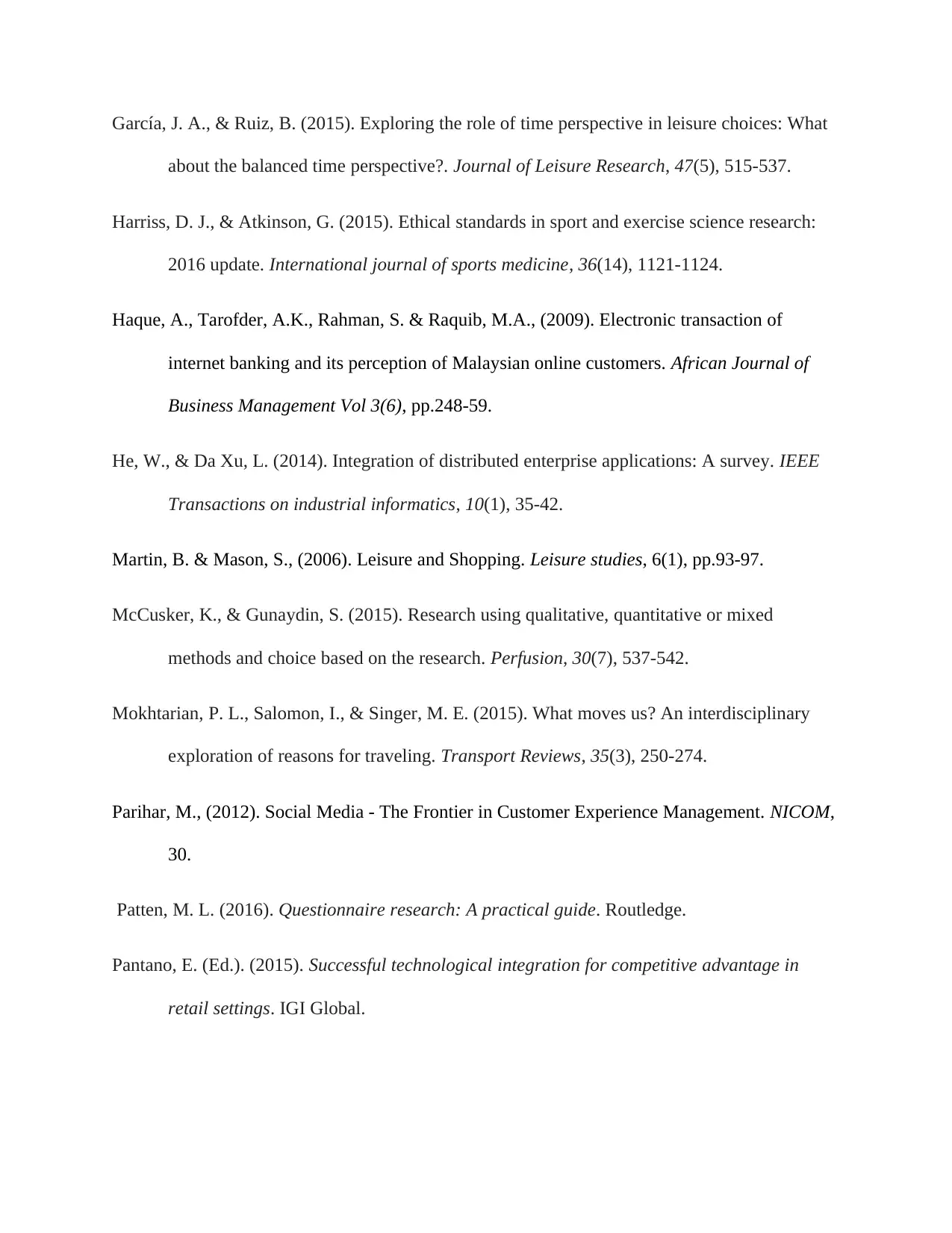
García, J. A., & Ruiz, B. (2015). Exploring the role of time perspective in leisure choices: What
about the balanced time perspective?. Journal of Leisure Research, 47(5), 515-537.
Harriss, D. J., & Atkinson, G. (2015). Ethical standards in sport and exercise science research:
2016 update. International journal of sports medicine, 36(14), 1121-1124.
Haque, A., Tarofder, A.K., Rahman, S. & Raquib, M.A., (2009). Electronic transaction of
internet banking and its perception of Malaysian online customers. African Journal of
Business Management Vol 3(6), pp.248-59.
He, W., & Da Xu, L. (2014). Integration of distributed enterprise applications: A survey. IEEE
Transactions on industrial informatics, 10(1), 35-42.
Martin, B. & Mason, S., (2006). Leisure and Shopping. Leisure studies, 6(1), pp.93-97.
McCusker, K., & Gunaydin, S. (2015). Research using qualitative, quantitative or mixed
methods and choice based on the research. Perfusion, 30(7), 537-542.
Mokhtarian, P. L., Salomon, I., & Singer, M. E. (2015). What moves us? An interdisciplinary
exploration of reasons for traveling. Transport Reviews, 35(3), 250-274.
Parihar, M., (2012). Social Media - The Frontier in Customer Experience Management. NICOM,
30.
Patten, M. L. (2016). Questionnaire research: A practical guide. Routledge.
Pantano, E. (Ed.). (2015). Successful technological integration for competitive advantage in
retail settings. IGI Global.
about the balanced time perspective?. Journal of Leisure Research, 47(5), 515-537.
Harriss, D. J., & Atkinson, G. (2015). Ethical standards in sport and exercise science research:
2016 update. International journal of sports medicine, 36(14), 1121-1124.
Haque, A., Tarofder, A.K., Rahman, S. & Raquib, M.A., (2009). Electronic transaction of
internet banking and its perception of Malaysian online customers. African Journal of
Business Management Vol 3(6), pp.248-59.
He, W., & Da Xu, L. (2014). Integration of distributed enterprise applications: A survey. IEEE
Transactions on industrial informatics, 10(1), 35-42.
Martin, B. & Mason, S., (2006). Leisure and Shopping. Leisure studies, 6(1), pp.93-97.
McCusker, K., & Gunaydin, S. (2015). Research using qualitative, quantitative or mixed
methods and choice based on the research. Perfusion, 30(7), 537-542.
Mokhtarian, P. L., Salomon, I., & Singer, M. E. (2015). What moves us? An interdisciplinary
exploration of reasons for traveling. Transport Reviews, 35(3), 250-274.
Parihar, M., (2012). Social Media - The Frontier in Customer Experience Management. NICOM,
30.
Patten, M. L. (2016). Questionnaire research: A practical guide. Routledge.
Pantano, E. (Ed.). (2015). Successful technological integration for competitive advantage in
retail settings. IGI Global.
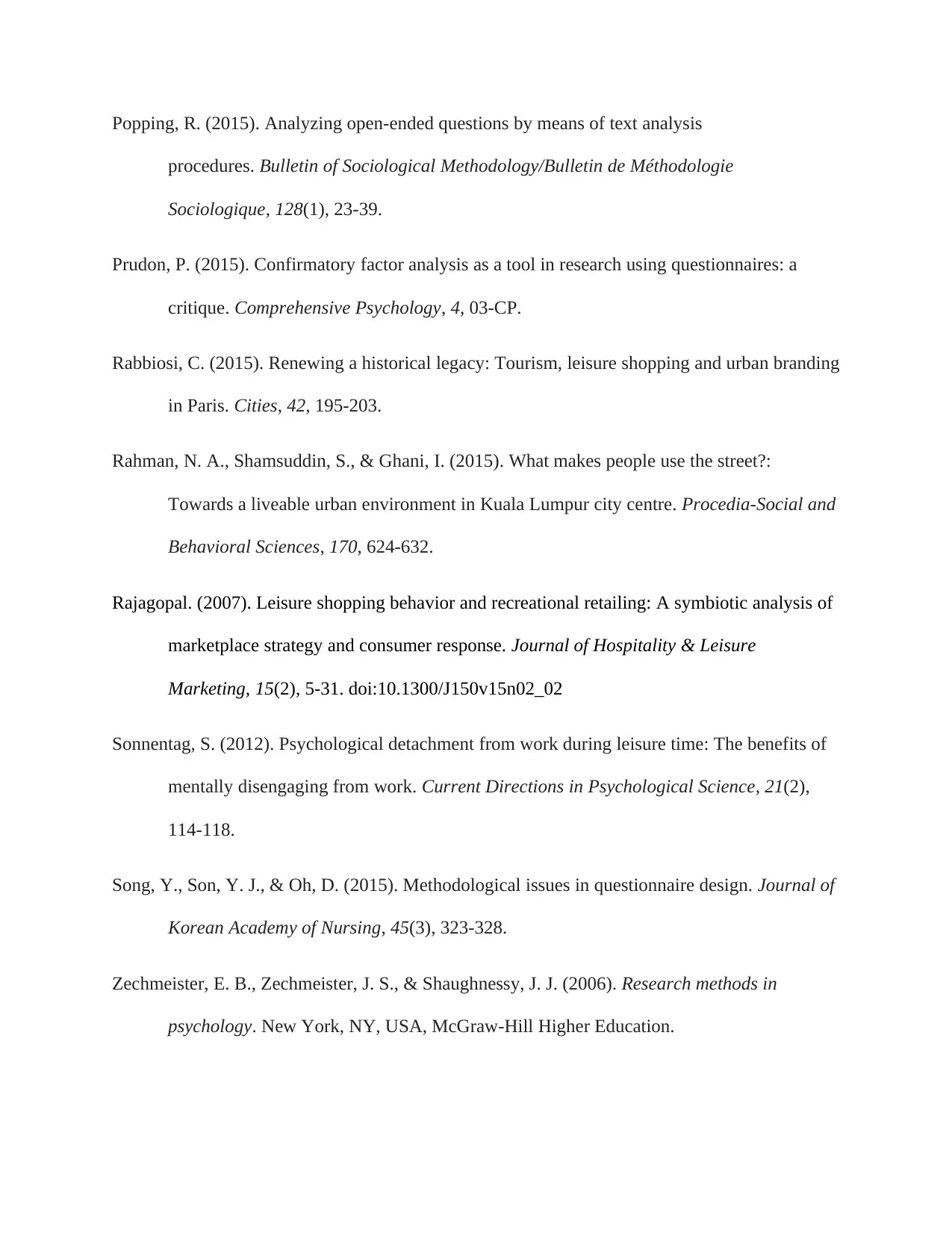
Popping, R. (2015). Analyzing open-ended questions by means of text analysis
procedures. Bulletin of Sociological Methodology/Bulletin de Méthodologie
Sociologique, 128(1), 23-39.
Prudon, P. (2015). Confirmatory factor analysis as a tool in research using questionnaires: a
critique. Comprehensive Psychology, 4, 03-CP.
Rabbiosi, C. (2015). Renewing a historical legacy: Tourism, leisure shopping and urban branding
in Paris. Cities, 42, 195-203.
Rahman, N. A., Shamsuddin, S., & Ghani, I. (2015). What makes people use the street?:
Towards a liveable urban environment in Kuala Lumpur city centre. Procedia-Social and
Behavioral Sciences, 170, 624-632.
Rajagopal. (2007). Leisure shopping behavior and recreational retailing: A symbiotic analysis of
marketplace strategy and consumer response. Journal of Hospitality & Leisure
Marketing, 15(2), 5-31. doi:10.1300/J150v15n02_02
Sonnentag, S. (2012). Psychological detachment from work during leisure time: The benefits of
mentally disengaging from work. Current Directions in Psychological Science, 21(2),
114-118.
Song, Y., Son, Y. J., & Oh, D. (2015). Methodological issues in questionnaire design. Journal of
Korean Academy of Nursing, 45(3), 323-328.
Zechmeister, E. B., Zechmeister, J. S., & Shaughnessy, J. J. (2006). Research methods in
psychology. New York, NY, USA, McGraw-Hill Higher Education.
procedures. Bulletin of Sociological Methodology/Bulletin de Méthodologie
Sociologique, 128(1), 23-39.
Prudon, P. (2015). Confirmatory factor analysis as a tool in research using questionnaires: a
critique. Comprehensive Psychology, 4, 03-CP.
Rabbiosi, C. (2015). Renewing a historical legacy: Tourism, leisure shopping and urban branding
in Paris. Cities, 42, 195-203.
Rahman, N. A., Shamsuddin, S., & Ghani, I. (2015). What makes people use the street?:
Towards a liveable urban environment in Kuala Lumpur city centre. Procedia-Social and
Behavioral Sciences, 170, 624-632.
Rajagopal. (2007). Leisure shopping behavior and recreational retailing: A symbiotic analysis of
marketplace strategy and consumer response. Journal of Hospitality & Leisure
Marketing, 15(2), 5-31. doi:10.1300/J150v15n02_02
Sonnentag, S. (2012). Psychological detachment from work during leisure time: The benefits of
mentally disengaging from work. Current Directions in Psychological Science, 21(2),
114-118.
Song, Y., Son, Y. J., & Oh, D. (2015). Methodological issues in questionnaire design. Journal of
Korean Academy of Nursing, 45(3), 323-328.
Zechmeister, E. B., Zechmeister, J. S., & Shaughnessy, J. J. (2006). Research methods in
psychology. New York, NY, USA, McGraw-Hill Higher Education.
1 out of 25
Related Documents
Your All-in-One AI-Powered Toolkit for Academic Success.
+13062052269
info@desklib.com
Available 24*7 on WhatsApp / Email
![[object Object]](/_next/static/media/star-bottom.7253800d.svg)
Unlock your academic potential
© 2024 | Zucol Services PVT LTD | All rights reserved.





